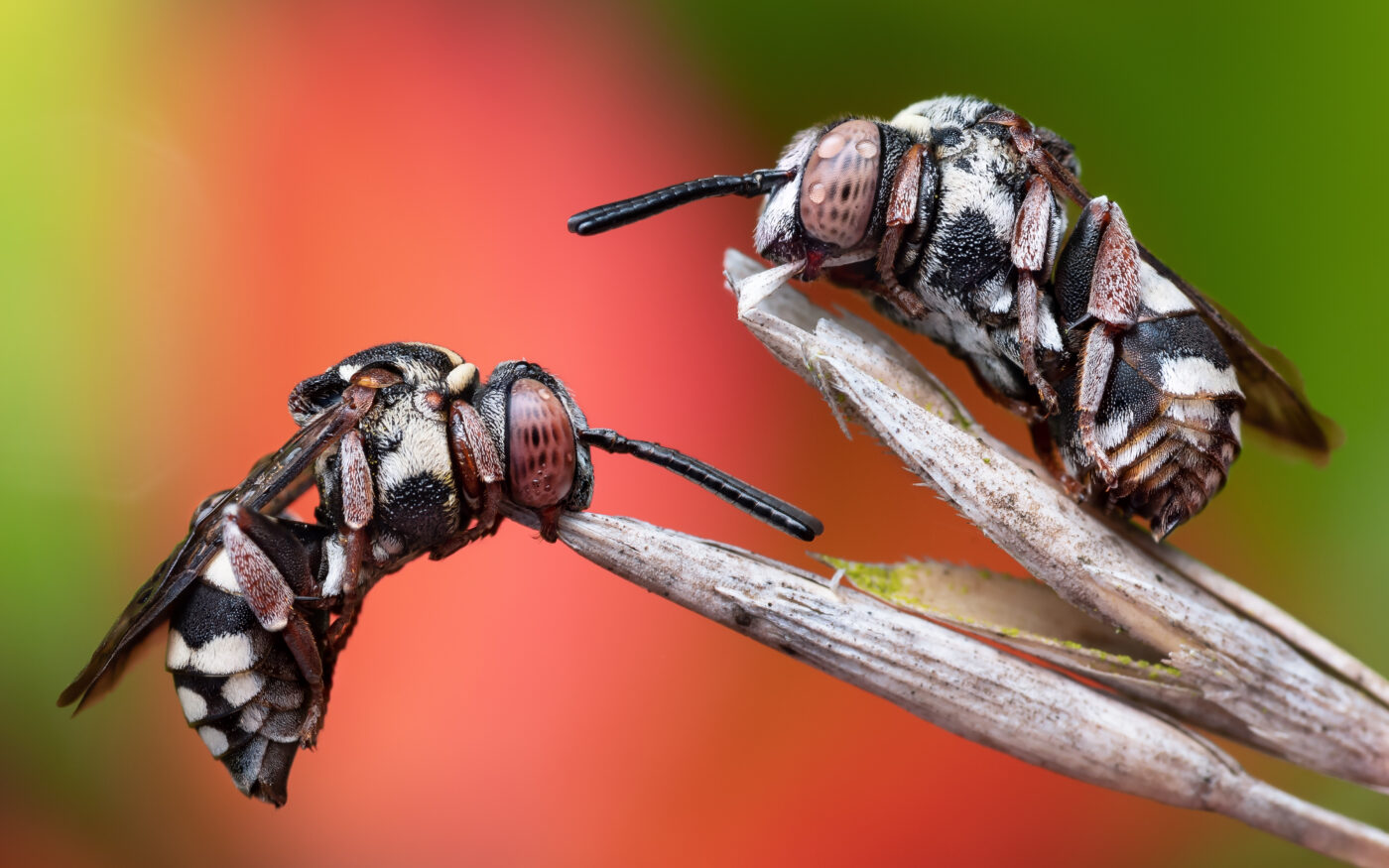View the fantastic winning entries for the 2023 Photography Competition (Over 18 Category) below.
1st place
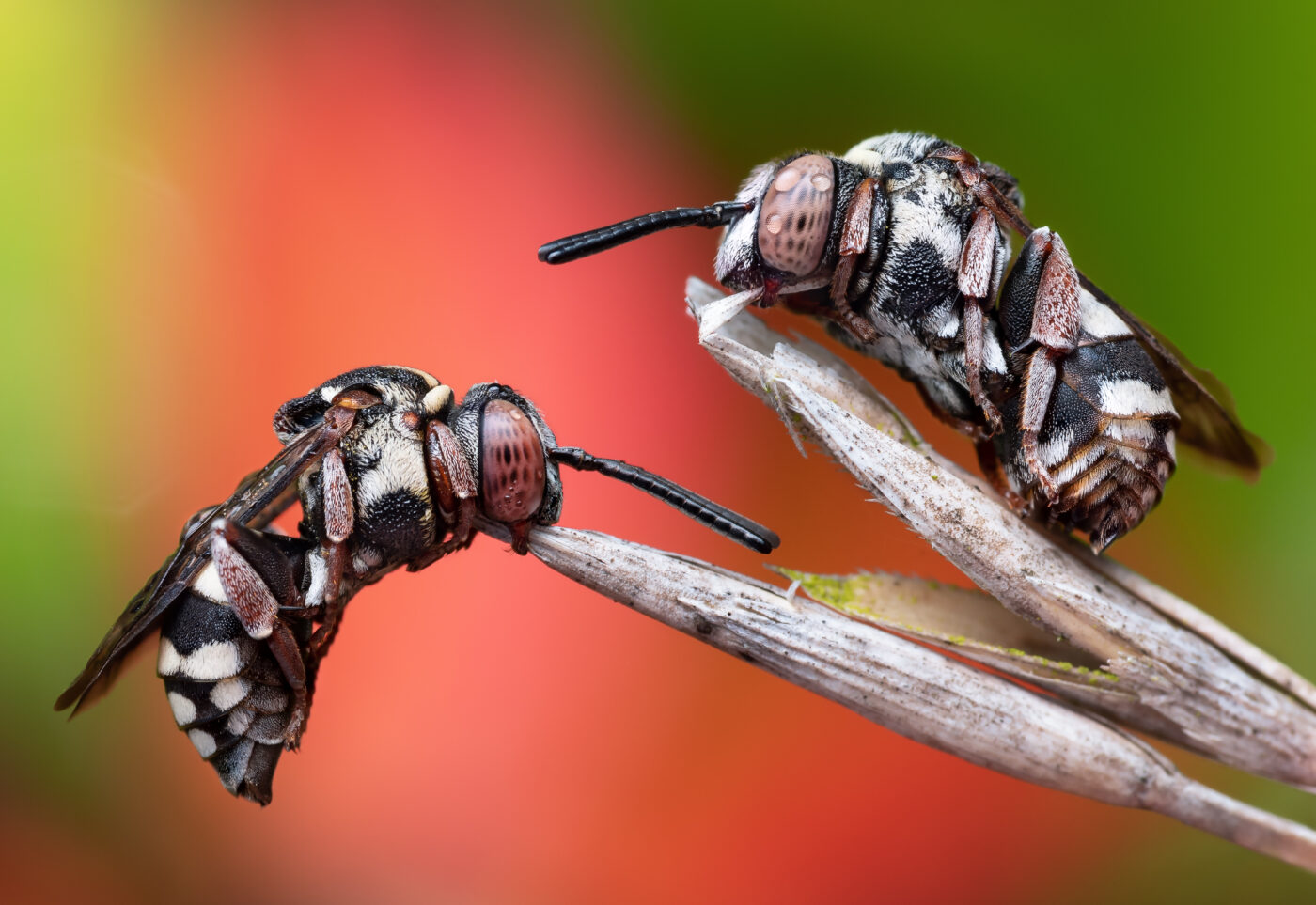
Sleeping Cuckoos
Luke Chambers
Black-thighed Cellophane-cuckoo bees, Epeolus variegatus.
Two cuckoo bees (Epeolus variegatus) fast asleep, grasping onto the grass with their mandibles. Still with a few drops of morning dew on them.
“Something I didn’t expect to see when I visited a fairly new location to me, but one of my best encounters to date. Finding any sleeping invertebrate is always brilliant, but two so close together, well that’s like winning the photography lottery!”
United Kingdom.
- Ants, bees, wasps and sawflies
2nd place
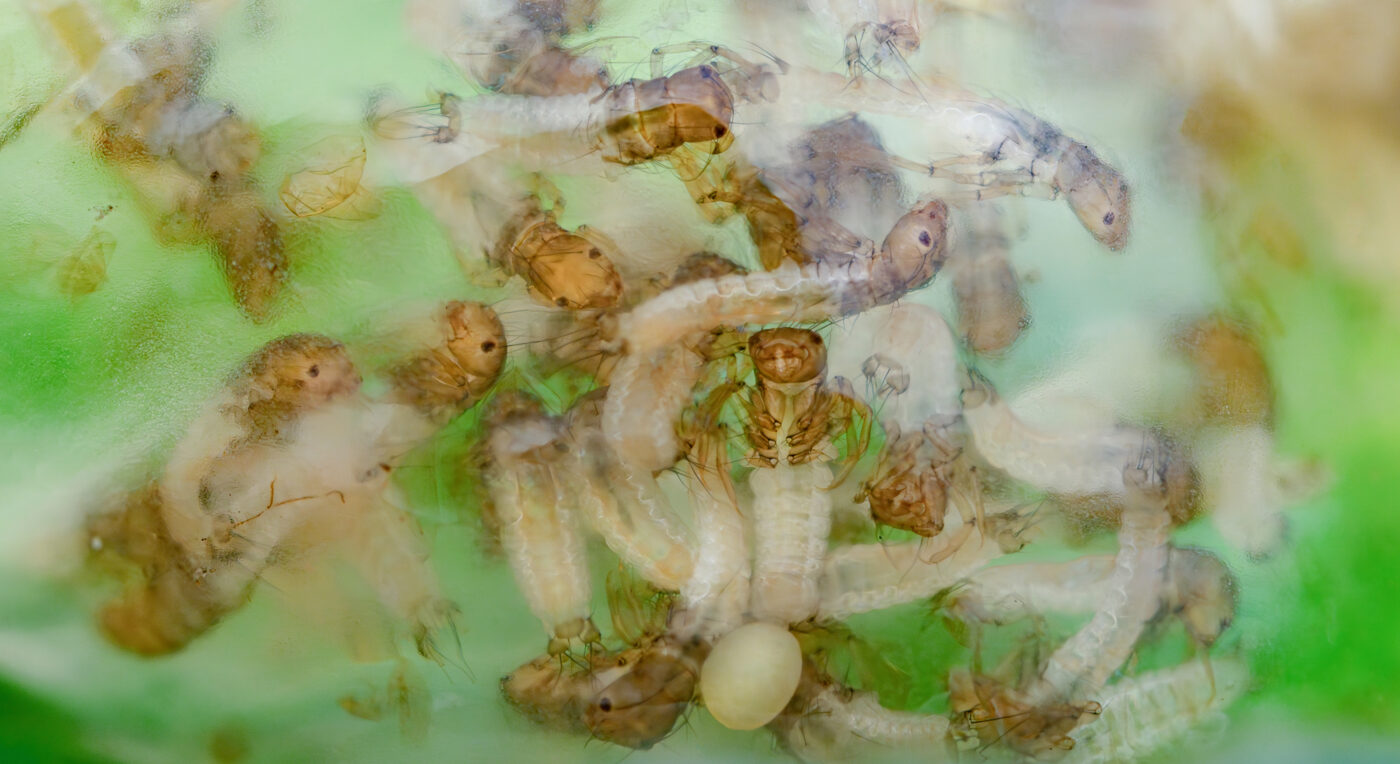
Caddisfly larvae in a jelly egg sac
Tim Jonas
Mottled Sedge caddisfly, Glyphotaelius pellucidus.
Photographed in-situ on a leaf overhanging water, this image shows recently hatched caddisfly larvae inside a transparent gelatinous egg sac. The larvae will drop into the water where they live as aquatic insects throughout the larval and pupal stages.
“Having photographed a Caddisfly laying her eggs at this location the previous year, I was keen to document the next stage showing eggs and larvae inside the gelatinous mass. I captured images of several egg masses near water, returning a few days later to find they had hatched.”
United Kingdom
- Caddisflies or sedge flies
Specially Commended – Behaviour
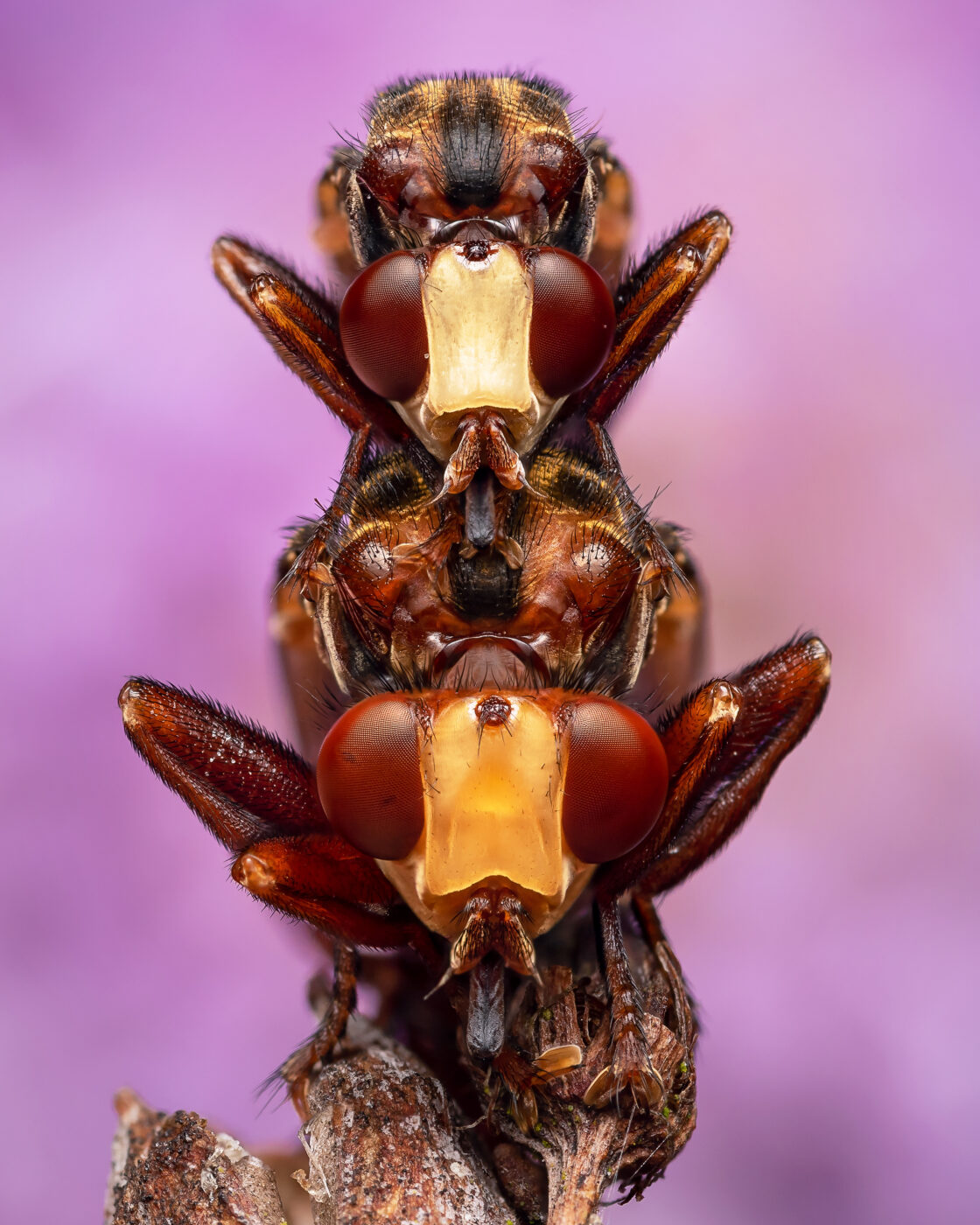
Conopidae Column
Luke Chambers
Ferruginous Bee-grabber thick-headed fly, Sicus ferrugineus.
Male and female Ferruginous Bee-grabbers (Sicus ferrugineus) embraced in a post-mating cuddle. The smaller male is actually mate guarding, making sure no other potential suiters ruins their evening. Handheld focus stack.
“Late one evening, after being reminded by my dog that he hadn’t been out for a walk, I took him and my camera to one of my favourite nature reserves. By sheer luck, my torch passed over this intimate scene… so my dog had to sit there for 5 minutes while I captured this image.”
United Kingdom
- True flies
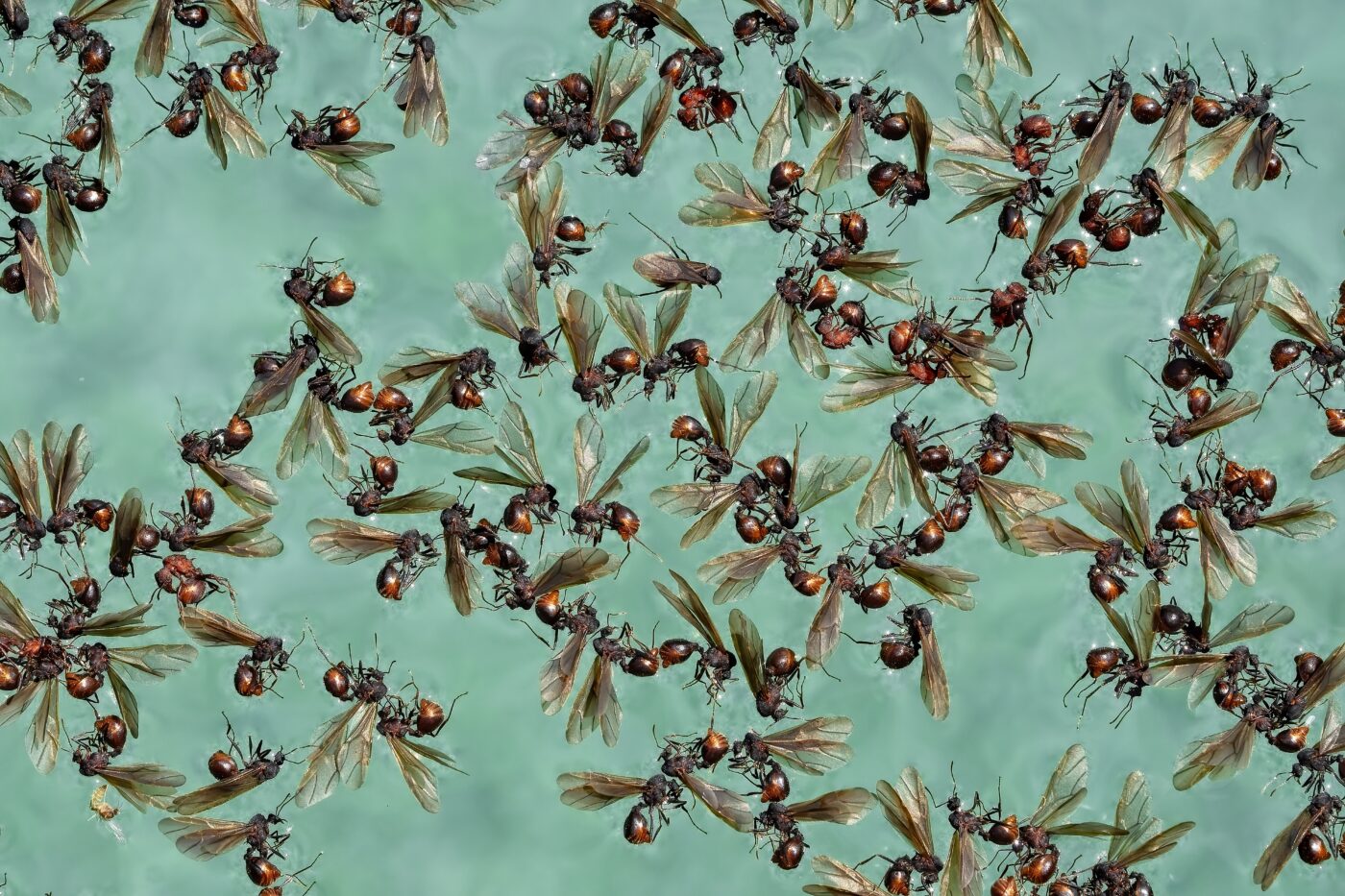
Fatal Attraction
Rosemary Haleem
Alate (winged) ants.
Swarm of flying ants desperate in a pool.
“On a very hot, breezy, August day, we awoke to find our pool totally covered with flying ants. The reflection of the pool and the winds seemed to have drawn them into the water. Most of them were unable to get out alive. I ran and got my camera to record the untimely demise.”
United States
- Ants, bees, wasps and sawflies
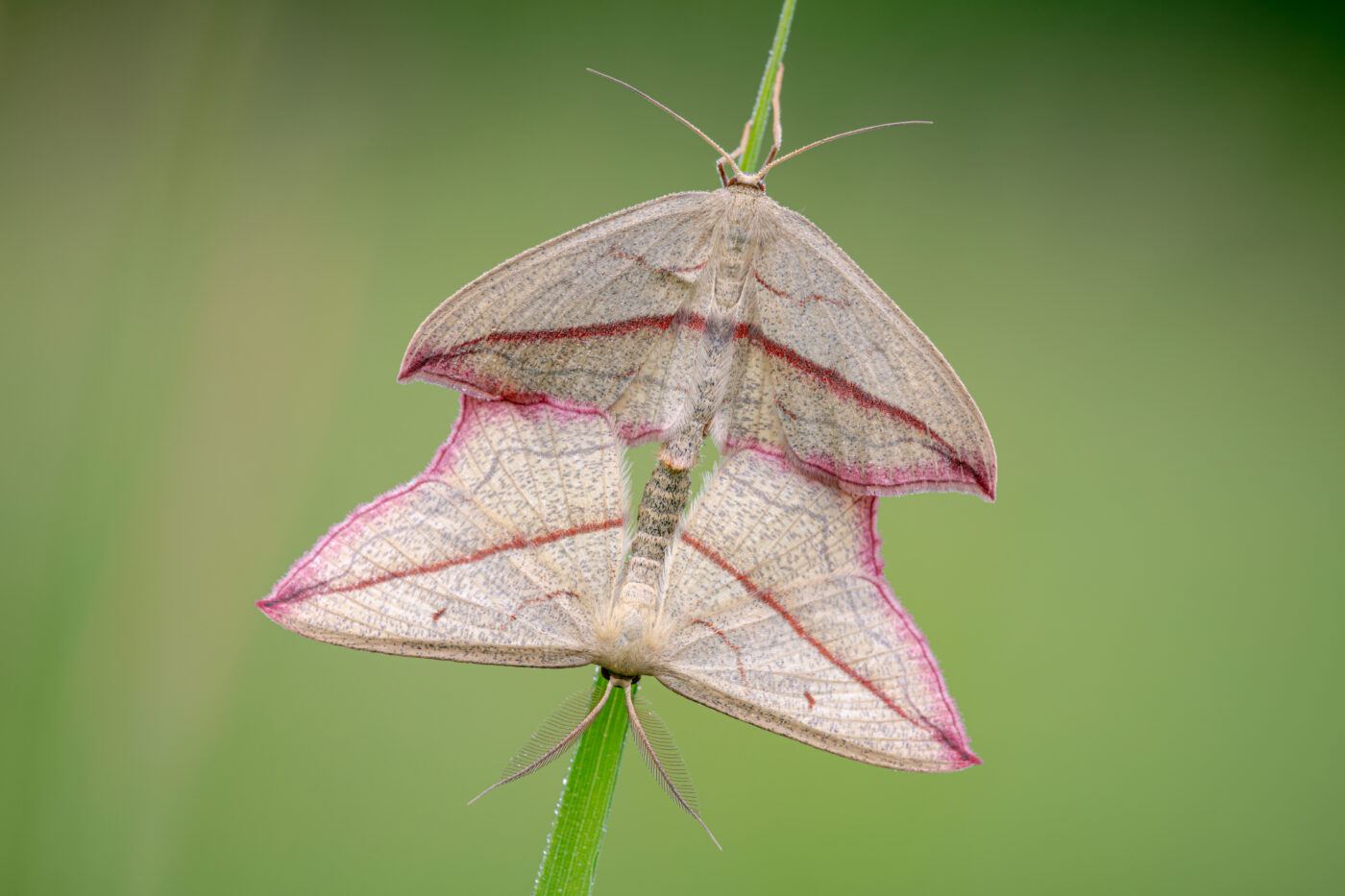
Mating Blood-veins
Heath McDonald
Blood-vein moths, Timandra comai.
Blood-vein moths are a member of the moth family geometridae, they get the name from the distinctive reddish line that runs from wingtip to wingtip. Usually on the wing in the UK from May to July, the caterpillars feed on Dock and Common Sorrell.
“One of our early morning visits to a 2 acre patch we are monitoring, we noticed a shape from a distance in the long grass. This mating pair had settled on a blade of grass. At this time of the morning there was no wind and a dew was forming, so managed to take a few photos.”
United Kingdom
- Butterflies and moths
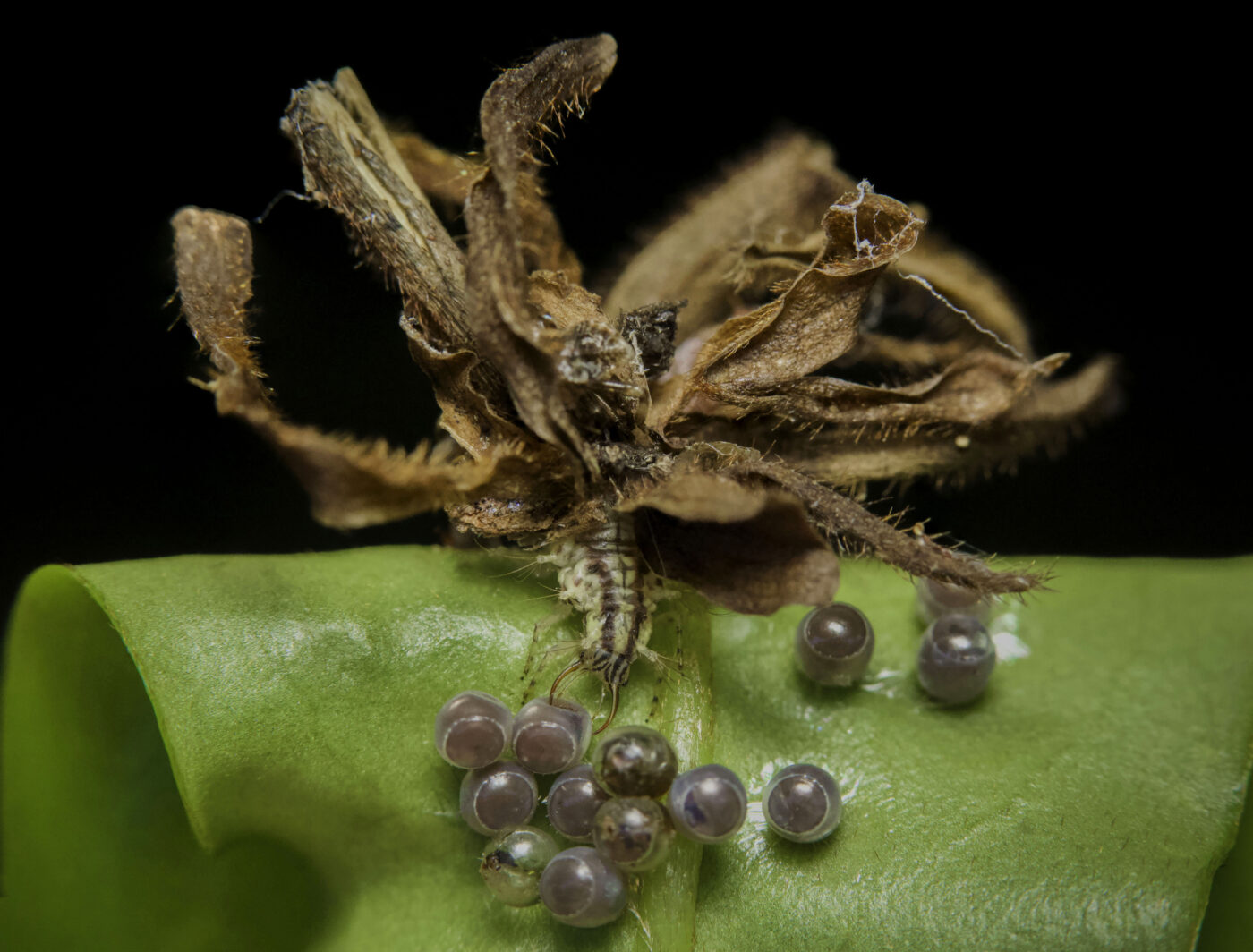
Junk Bug
Rosa Dunbar
Lacewing larva, Chrysopa sp.
The junk bug, a voracious predator in the insect world, earns its name by wearing plant matter and the exoskeletons of past victims on its back as part of an intricate camouflage to deceive predators.
Australia
- Lacewings, antlions and mantidflies
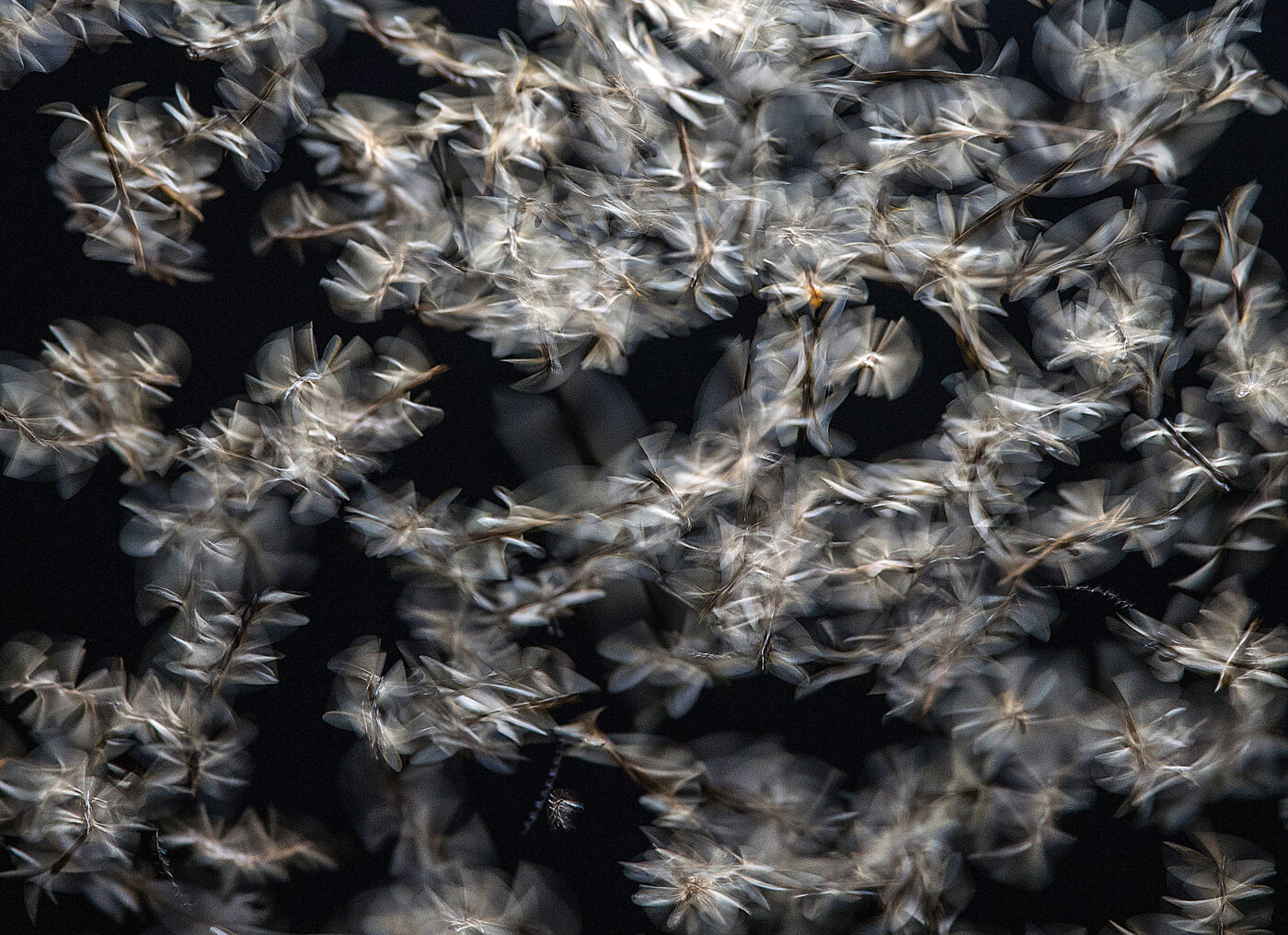
Flying termites
Sirsendu Gayen
Subterranean termites.
These flying termites, called alates, leave the safety of the colony in large numbers to breed and establish new colonies. This behavior is called swarming. Swarming termites may be most active during morning, evening or mid-day. Only a few species tend to swarm at night.
“It was a heavy rainy night at Silda near Jhargram when I made this image of flying termites after stopping the rain for half an hour. Termites are flying around a neon light after stopping the rain. It’s about 02:00 am. These flying termites, called alates, leave the safety of the colony in large numbers to breed and establish new colonies. This behavior is called swarming. Swarming termites may be most active during morning, evening or mid-day, again depending on species and other factors. Only a few species tend to swarm at night.”
India
- Cockroaches and termites
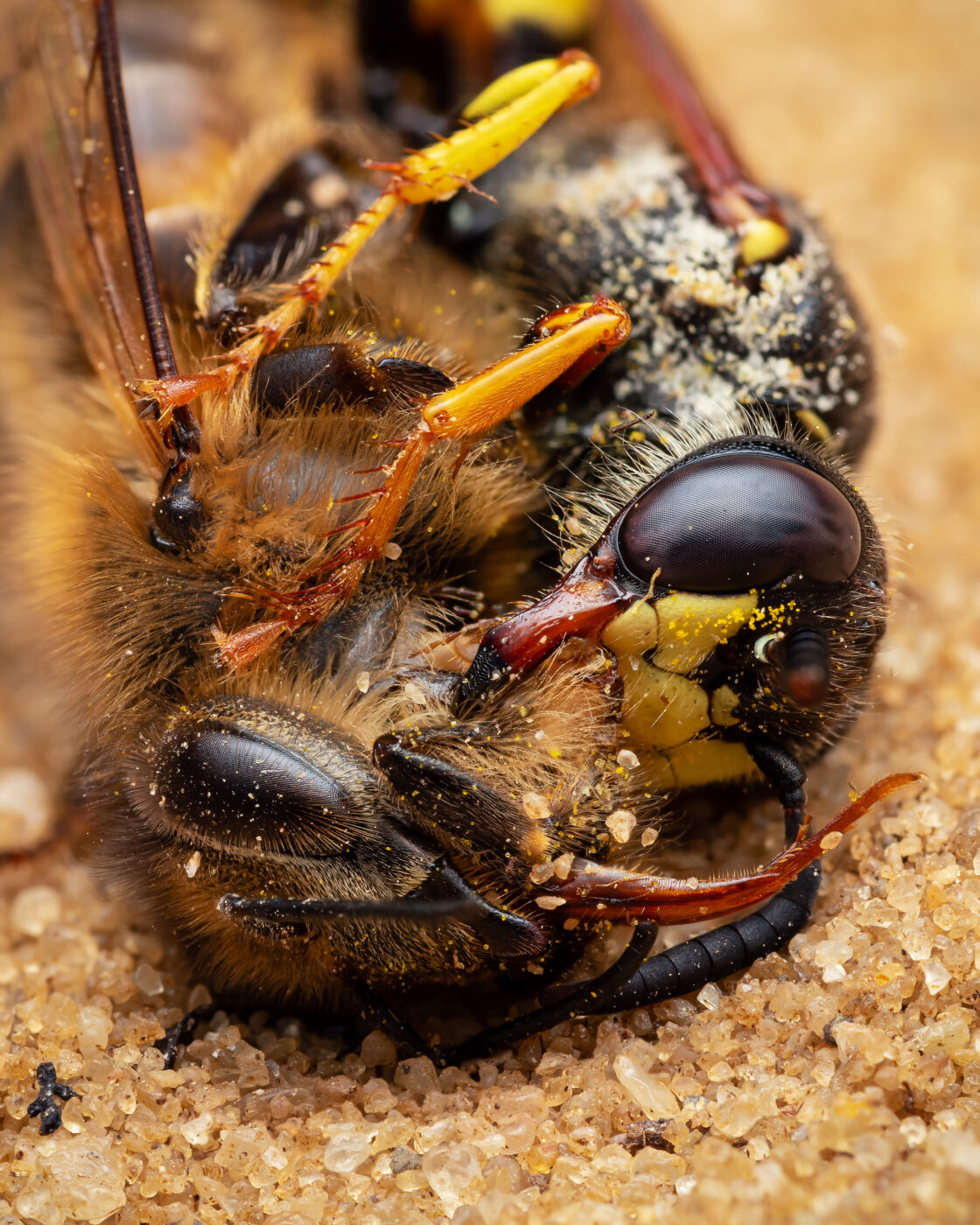
Clever Girl
Luke Chambers
European beewolf wasp, Philanthus triangulum.
Behaviour I hadn’t witnessed, seen, or read about online. A female European Beewolf (Philanthus triangulum) hastily squeezing the nectar out of a paralysed Honey Bee (Apis mellifera), and consuming it for herself. Handheld focus stack.
“I was shocked when I realised what was happening. Rather than take the Honey Bee back to one of her burrows for her future young to feed on, the Beewolf wanted that nectar for herself. Why waste time visiting all those flowers, when you can get a flying larder to do it for you.”
United Kingdom
- Ants, bees, wasps and sawflies
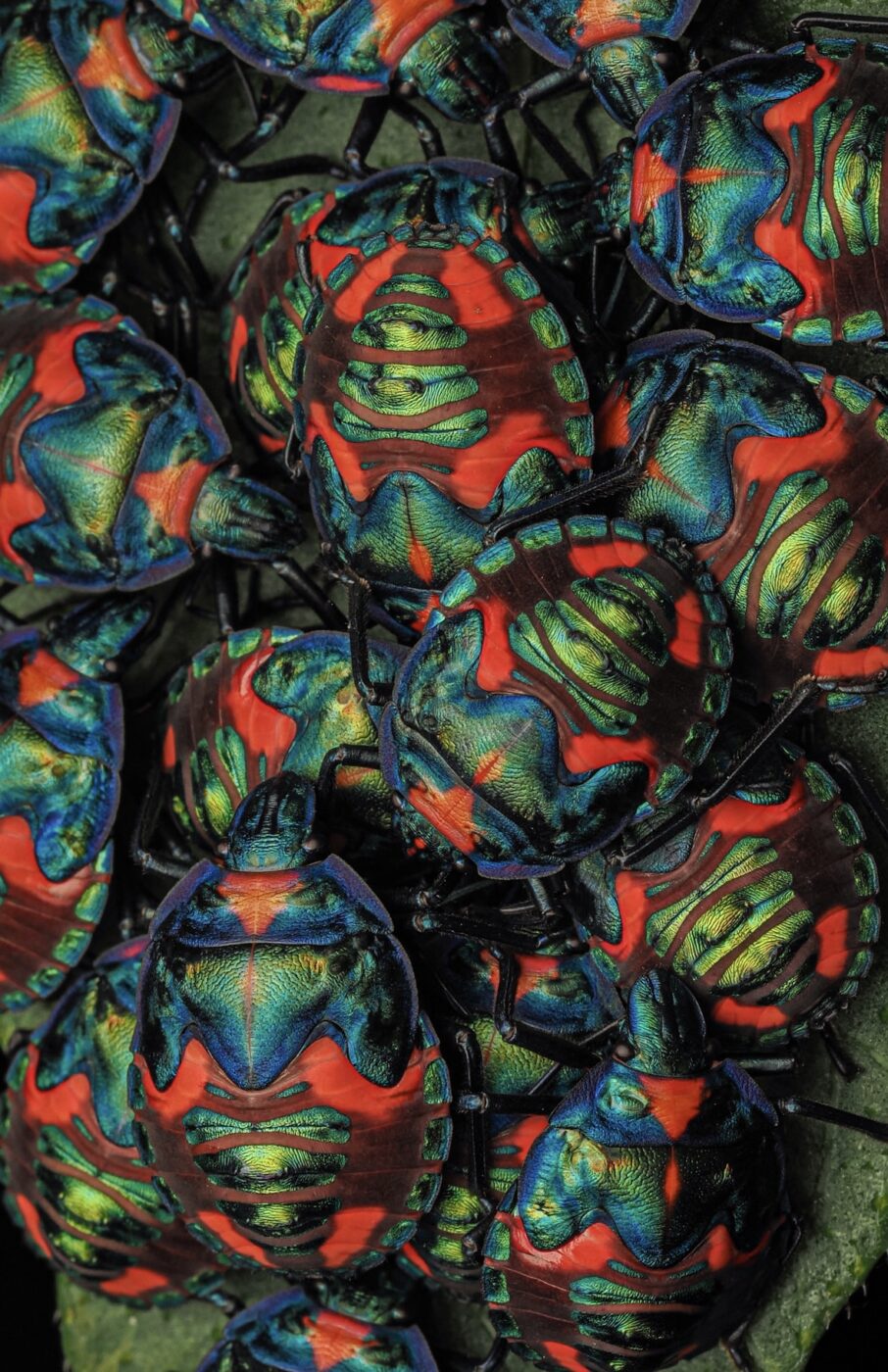
Natures jewels
Nikita Richardson
Cotton harlequin bugs, Tectocoris diophthalmus, final-instar nymphs.
A cluster of male harlequin bugs.
“Clustering behaviour is an advantage to survival. When one bug emits a bad smell as a deterrent for predators it will trigger the others to do so as well!”
Australia
- True bugs
Specially Commended – Portraits
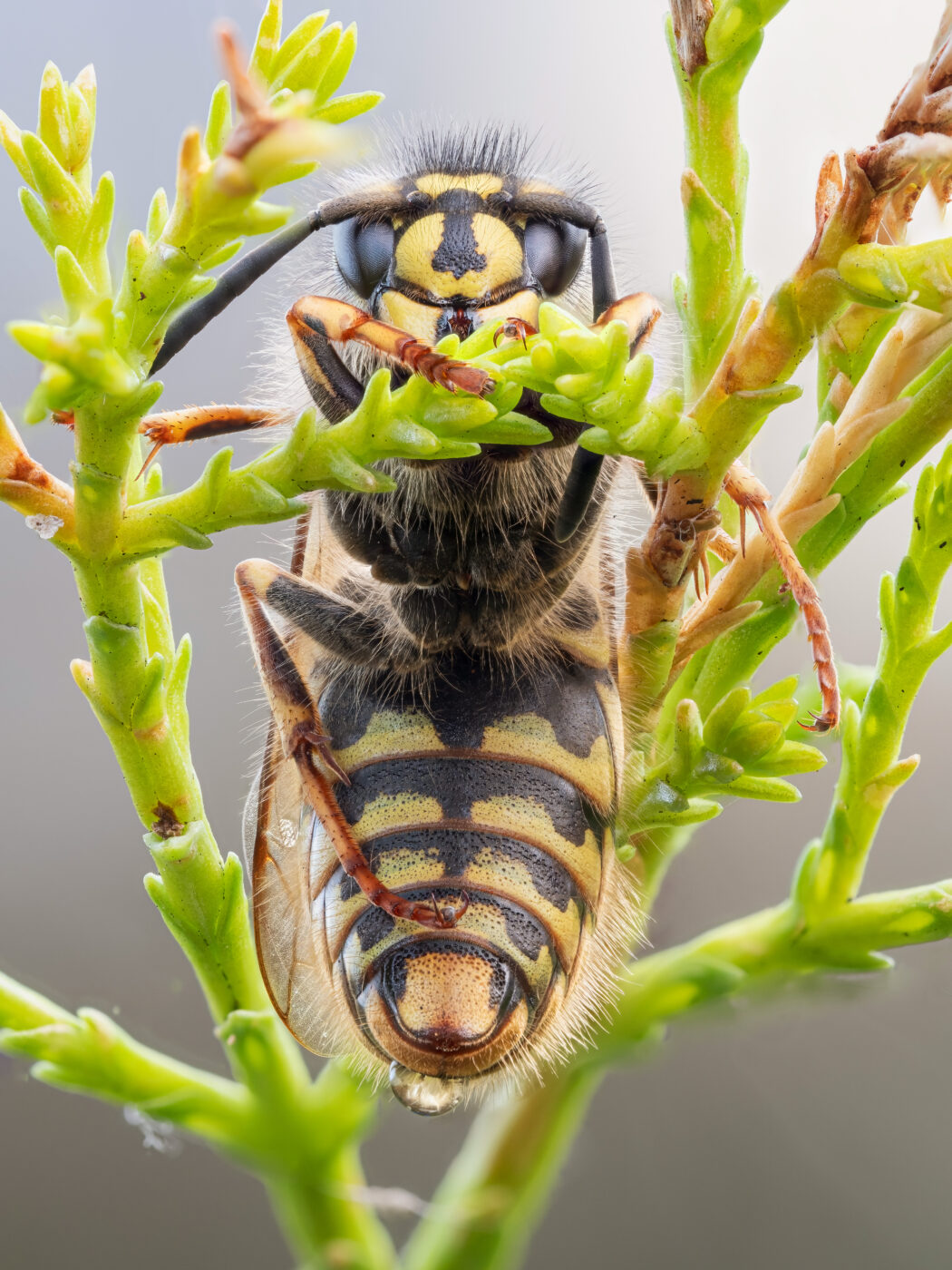
Conifer Wasp
Steven Mahy
Common wasp, Vespula vulgaris.
A wasp found settled in a conifer tree. Focus stack taken in natural light.
“Found this wasp settled in a conifer tree in my garden, February 2023.”
Guernsey
- Ants, bees, wasps and sawflies
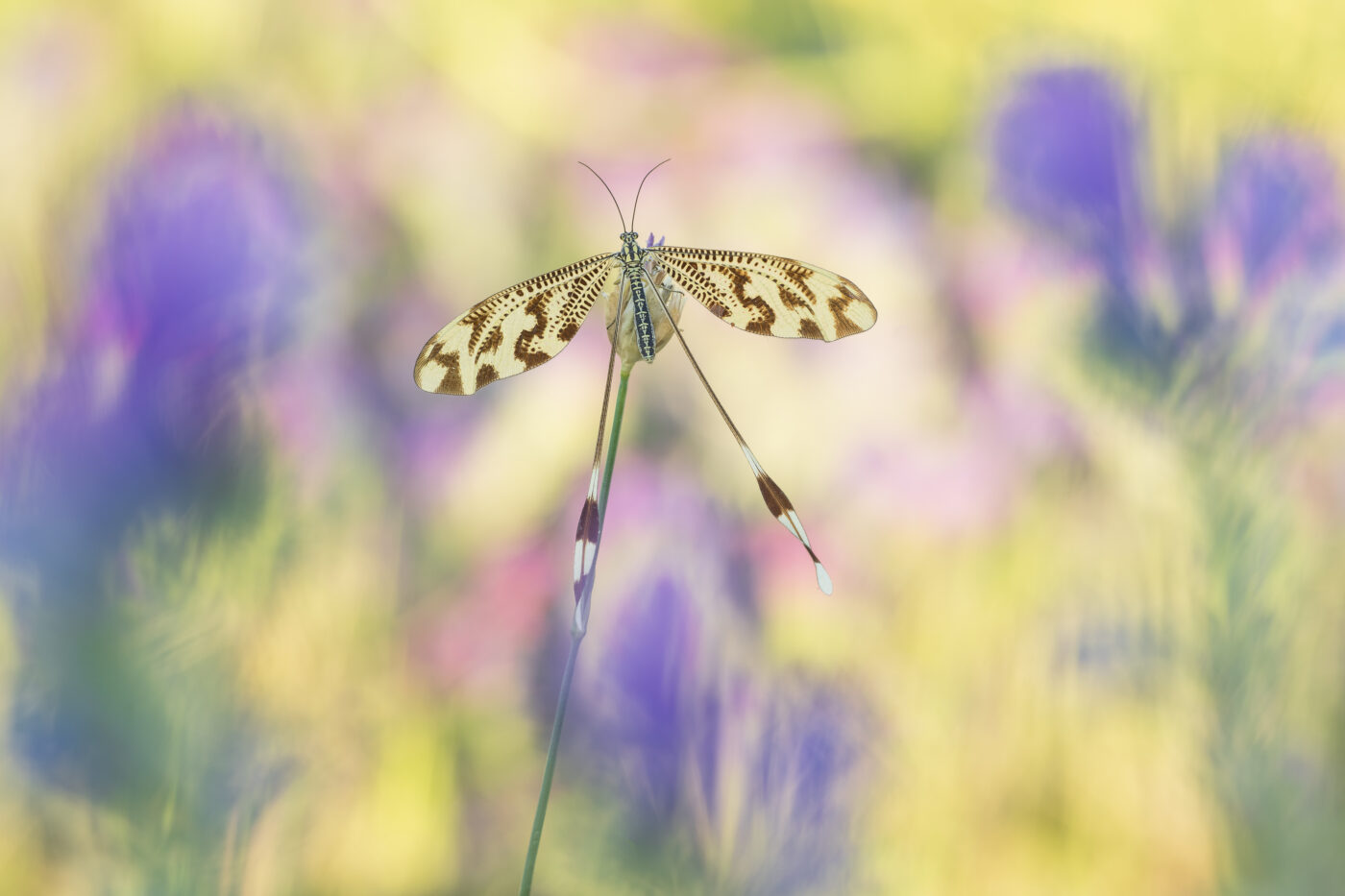
Spoonwing
Katarzyna Bukowska
Two-winged spoonwing, Nemoptera bipennis.
Image was taken in June, Spoonwing is taking sun before it flies of. In the backdrop there is a kaleidoscope of colours created by meadow flowers.
Spain
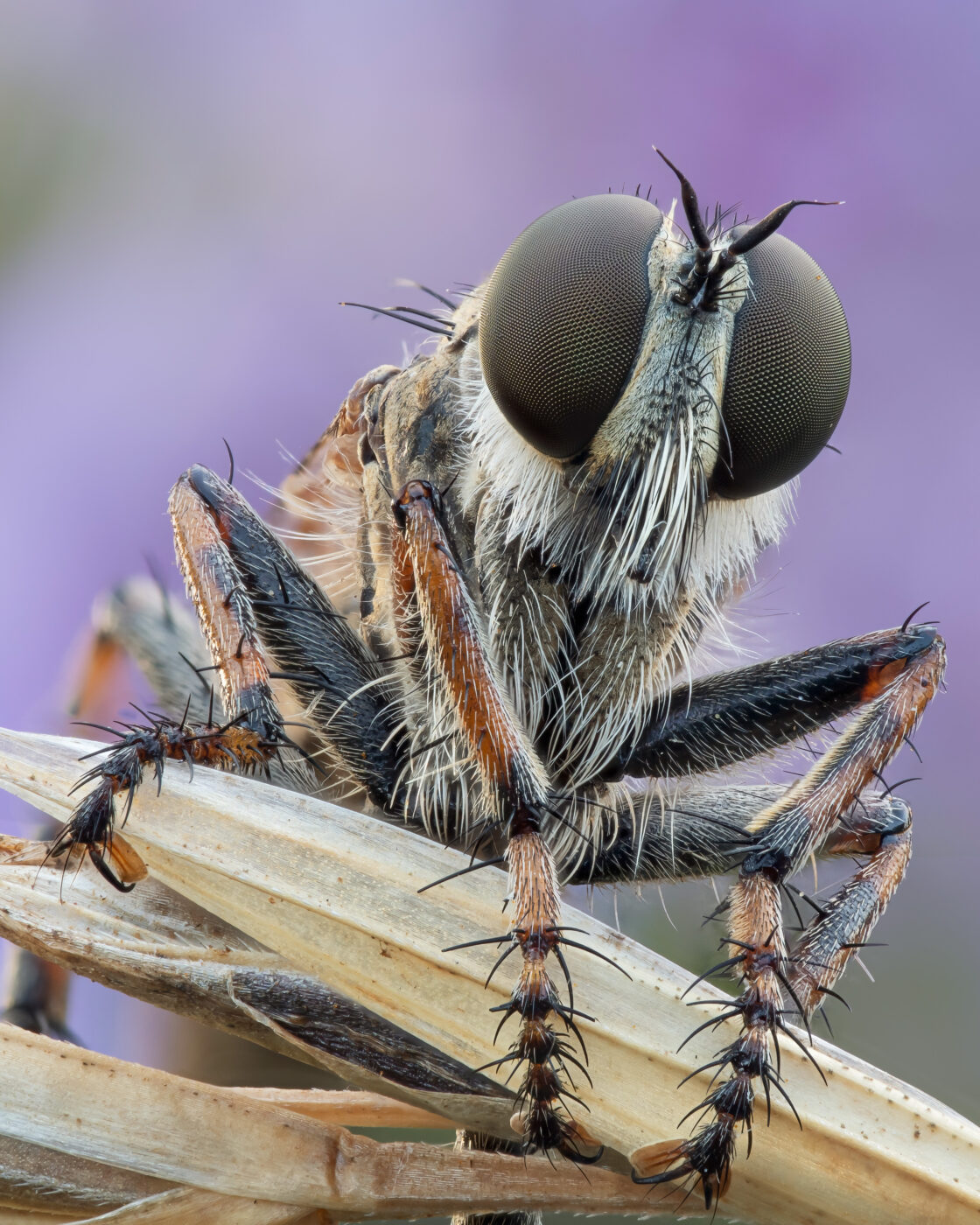
Robber fly
Steven Mahy
Brown heath robber fly, Epitriptus cingulatus.
A robber fly found settled on long grass, Droxford, Hampshire. Focus stack taken in natural light.
“I was looking for butterflies an hour or so before sunset, in an area where I had seen plenty in the daytime. Could not find a single butterfly but then noticed this robber fly.”
United Kingdom
- True flies
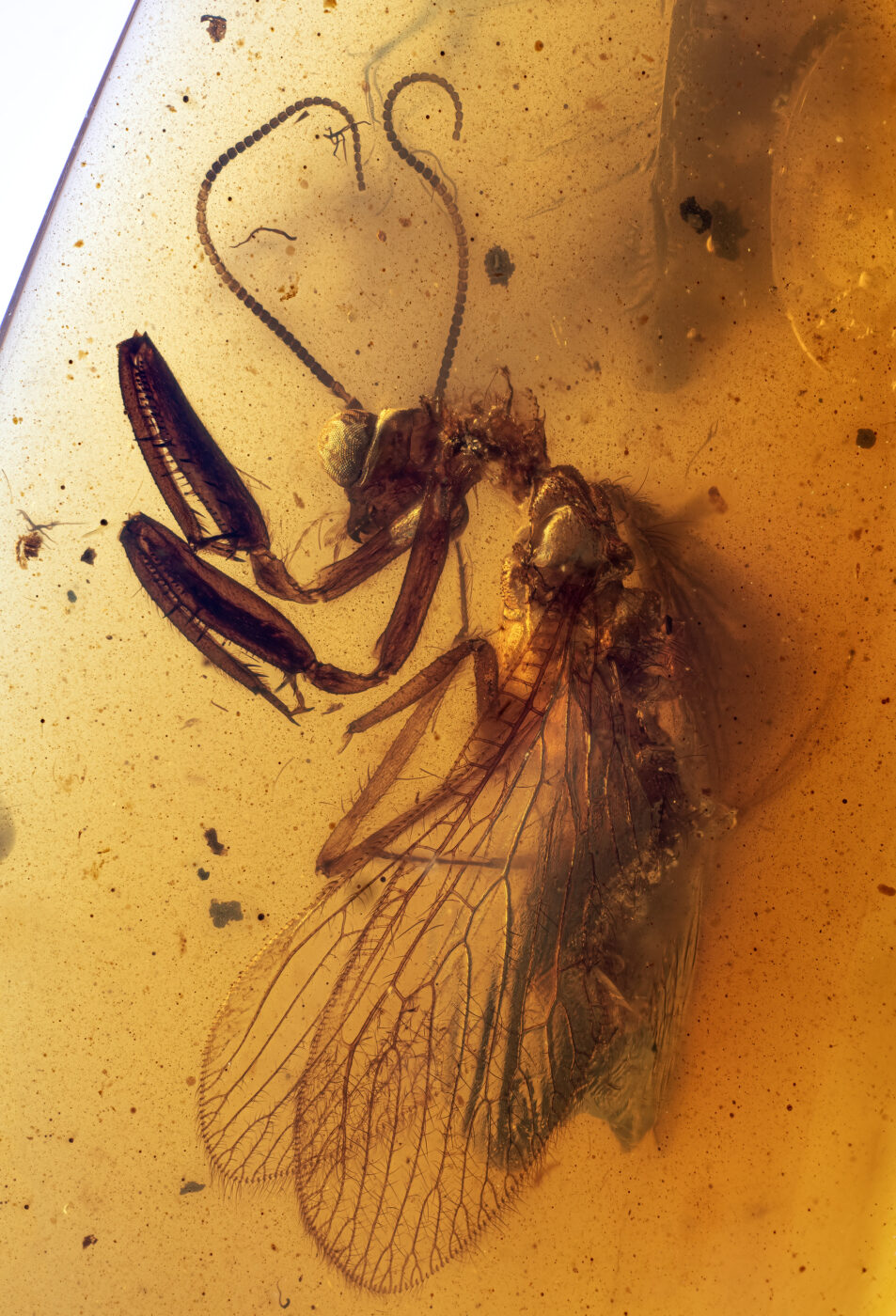
Neuropteran embedded in Burmese amber
Enrico Bonino
Thorny lacewings, Rachiberothidae.
This incredible specimen belongs to the Neuropterans insect family. It is characterized by two spiny raptorial forelimbs (similar to the Mantis) and big eyes. This insect is embedded in a ~99 million-year-old amber from the Hukawng Valley, Kackin State, Myanmar.
“Imagine a beautiful day full of amazing creatures. The neuropteran’s eyes saw feathered dinosaurs, scaly reptiles, and the first mammals, hiding and running to avoid predators.
Unfortunately, during its hunt, it fell on a golden flow of resin. Forever.”
Belgium
- Lacewings, antlions and mantidflies
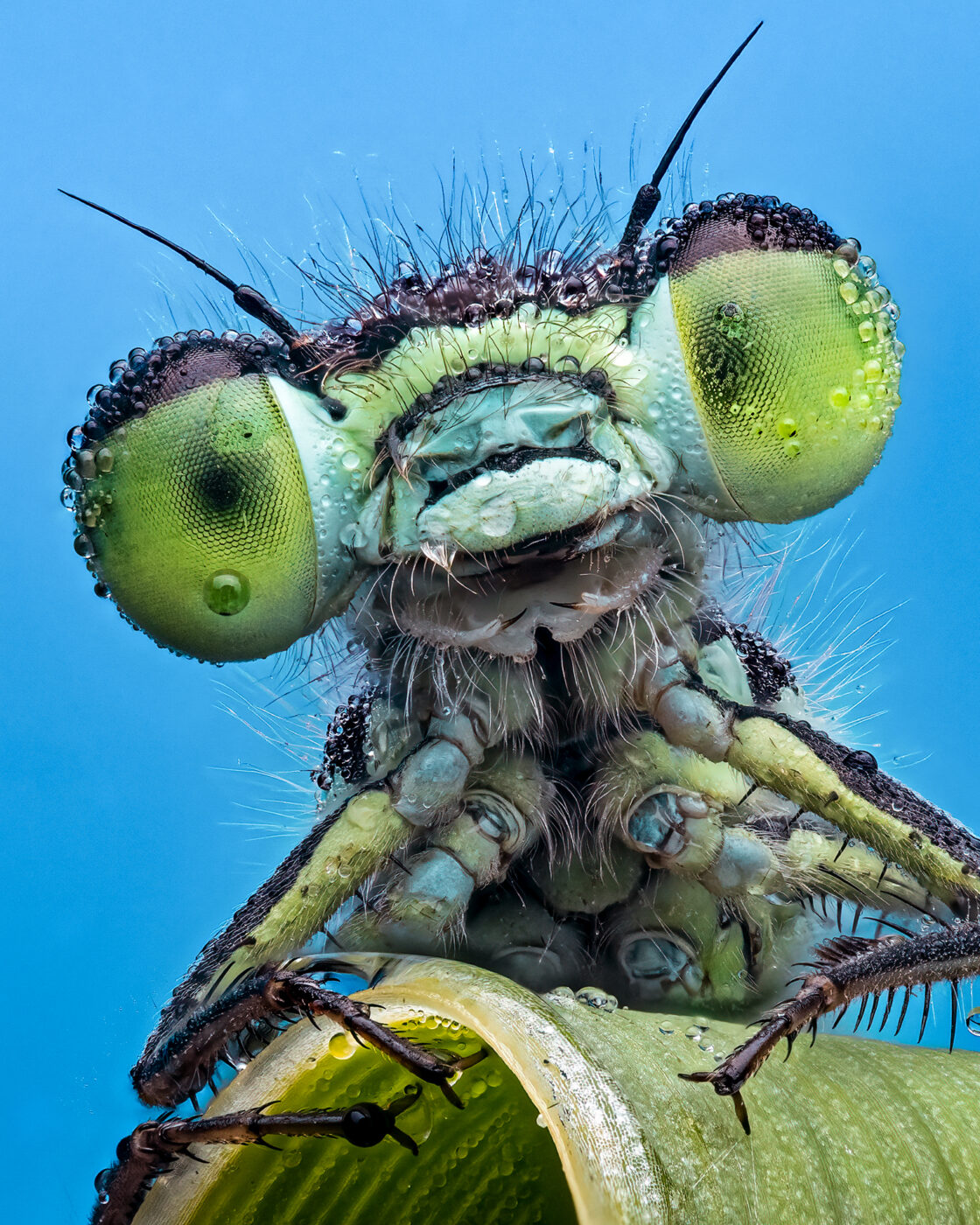
Look into my eyes
Pete Burford
Damselfly
Here is a Damselfly covered in Dew in the middle of the night. Insects are cold blooded, so as the temperature cools at night, they are unable to move. Dew then sticks to the Damselfly and covers it completely.
“I was out searching for Damselflies in the middle of the night around 2am to find one covered in dew. I lucked out near a fishing pond and found a couple of them still on the reads covered in dew. I was able to get quite a few interesting poses of them whilst I was there.”
United Kingdom
- Dragonflies and damselflies
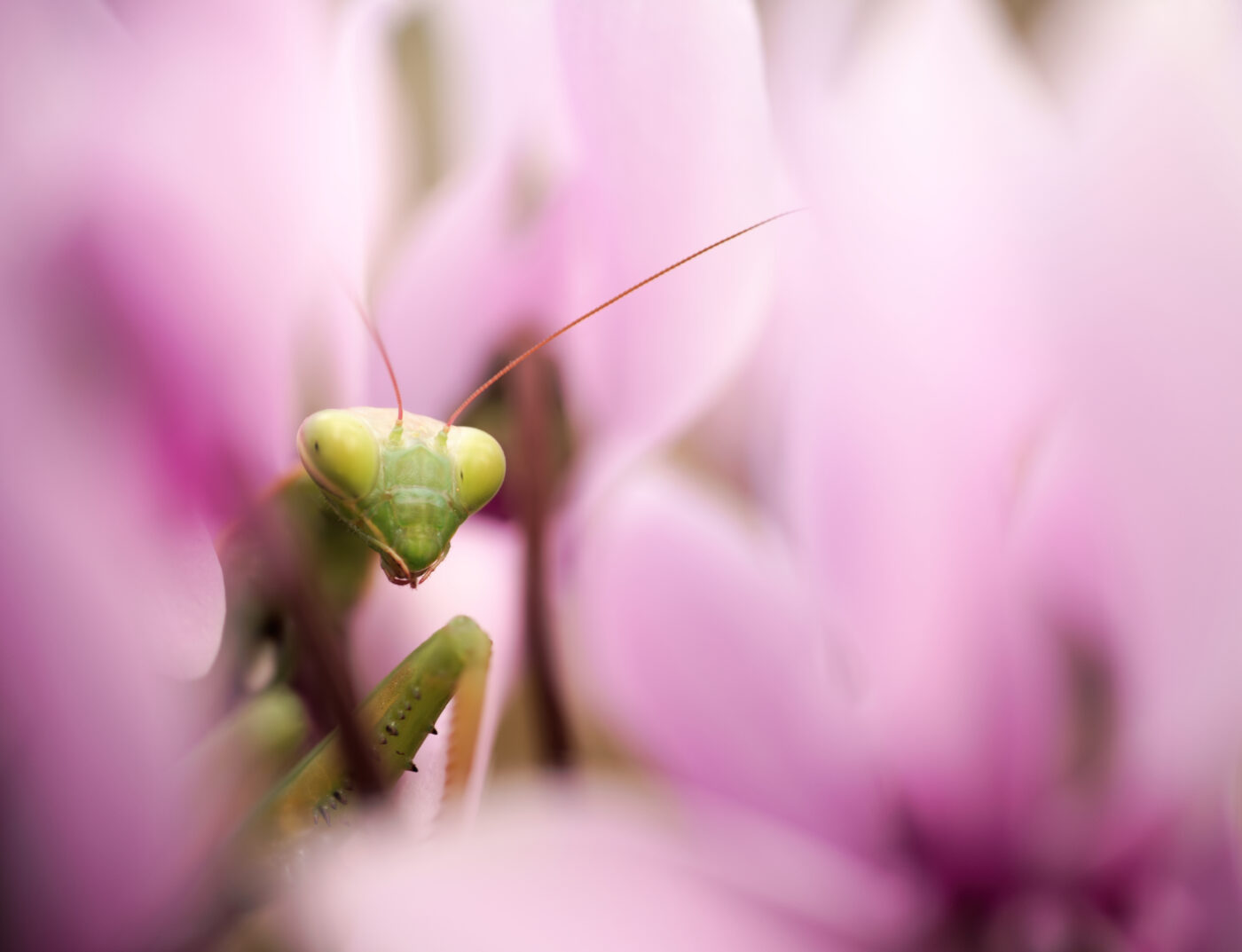
Les Fleurs du mal
Panagiotis Dalagiorgos
European mantis, Mantis religiosa.
A mantis religiosa among some cyclamen.
“I love the way she peeks through the cyclamens, breaking the pink/magenta pattern with some green/yellow. I think it adds some mystery and danger to the beautiful flower scenery. I utilized the sunlight and used a diffusion umbrella to soften the light.”
Greece
- Mantises
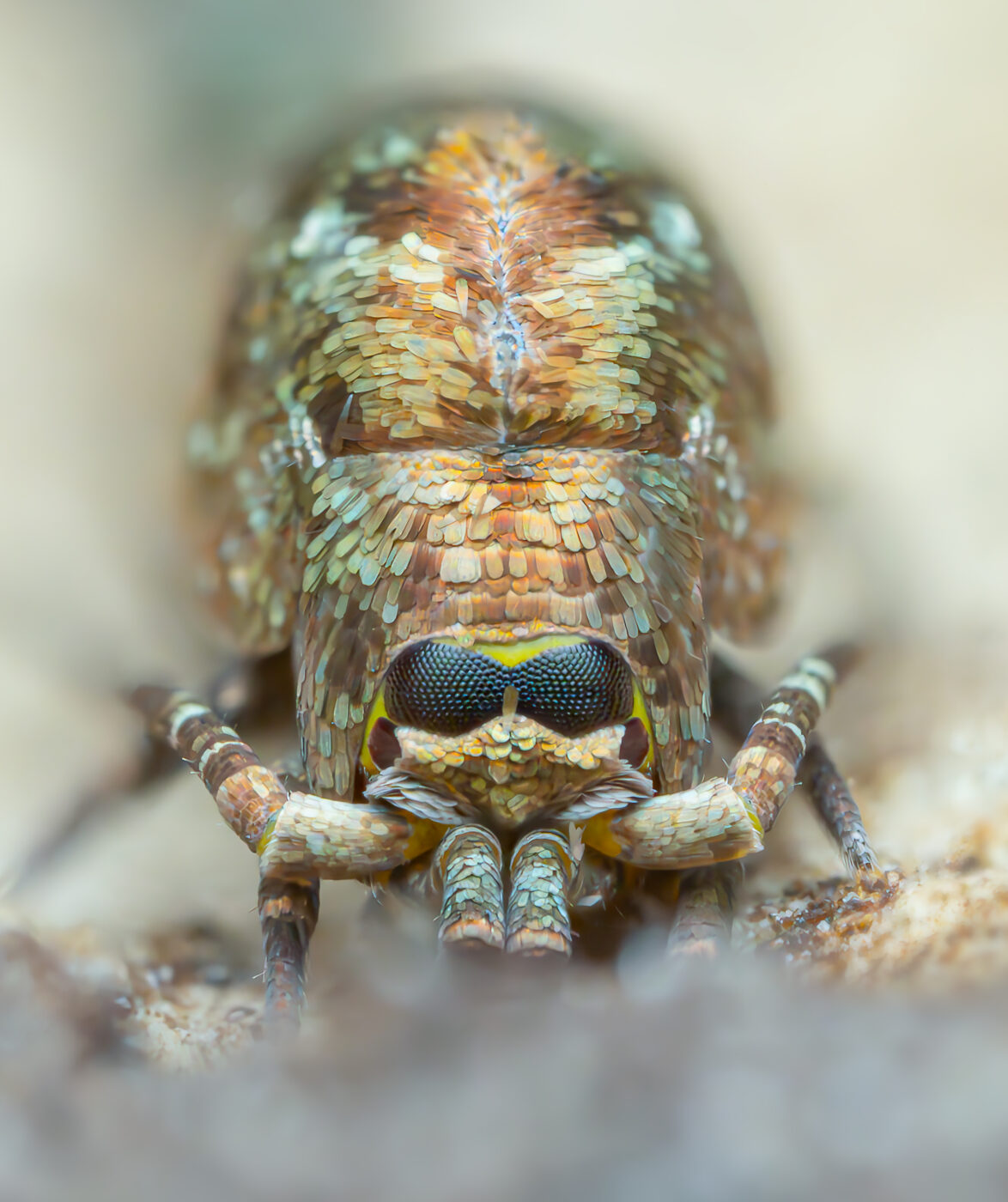
Jumping bristletail, Dilta sp.
Tim Jonas
Portrait of a Jumping Bristletail. Jumping bristletails are some of the most primitive insects alive today, pre-dating the dinosaurs by 200 million years. Often found under stones, these unique non-flying insects can jump several centimetres in the air and have a covering of scales that provide protection.
“One of my favourite subjects to photograph, I often find Jumping Bristletails under stones around the limestone crags during my walks at Brockadale Nature Reserve.”
- Bristletails
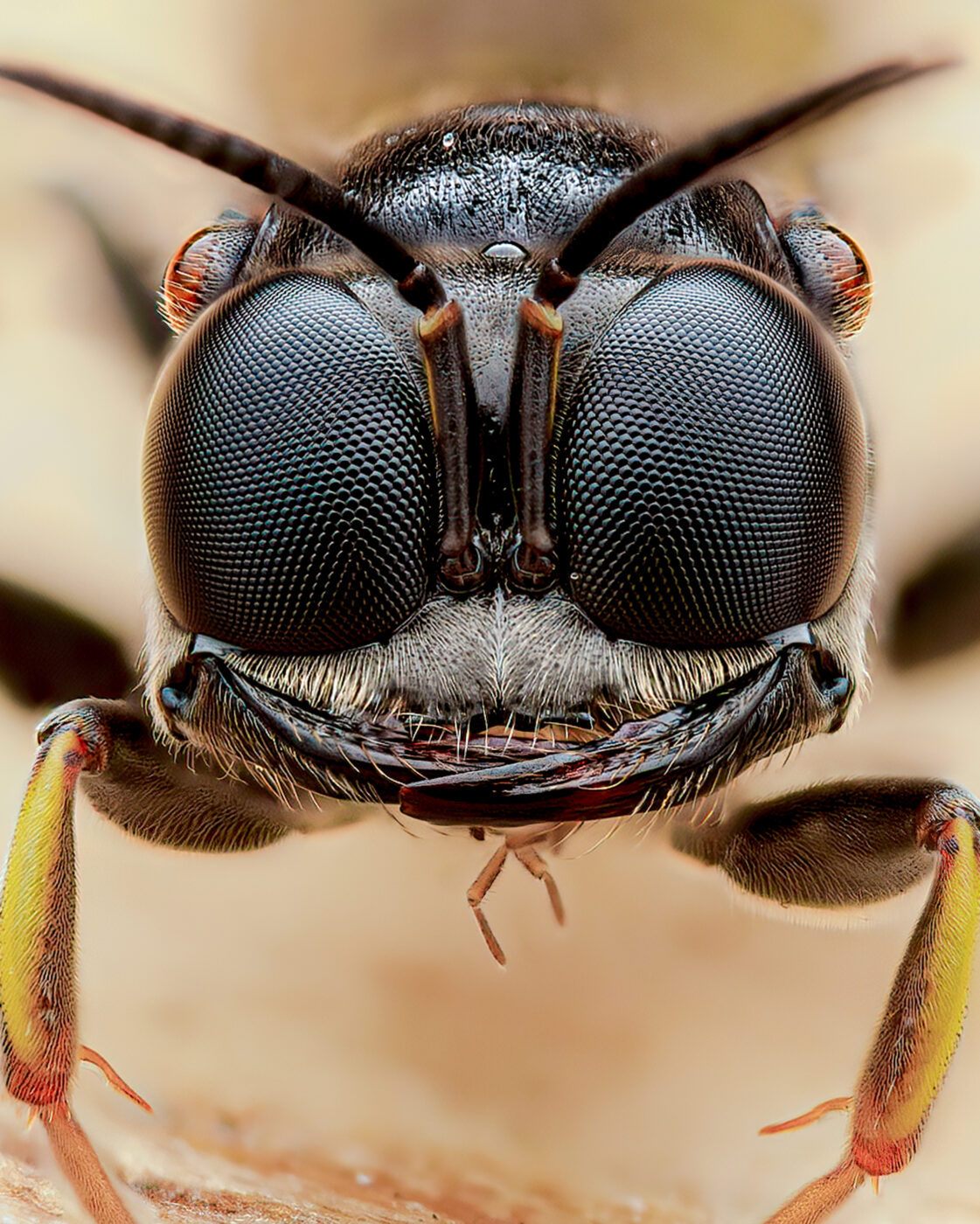
Gold Digger
Paul Fraser
Digger Wasp, Crabonidae.
A close-up portrait of a digger wasp species that I found excavating chambers in a raised bed planter at my work.
“I recently dug a raised flower bed at work using wooding railway sleepers. A few days after putting them up, I found sawdust on top of the soil. I then noticed a small wasp coming in and out of the wood. I grabbed my camera and got a picture of this small charismatic digger wasp.”
United Kingdom
- Ants, bees, wasps and sawflies
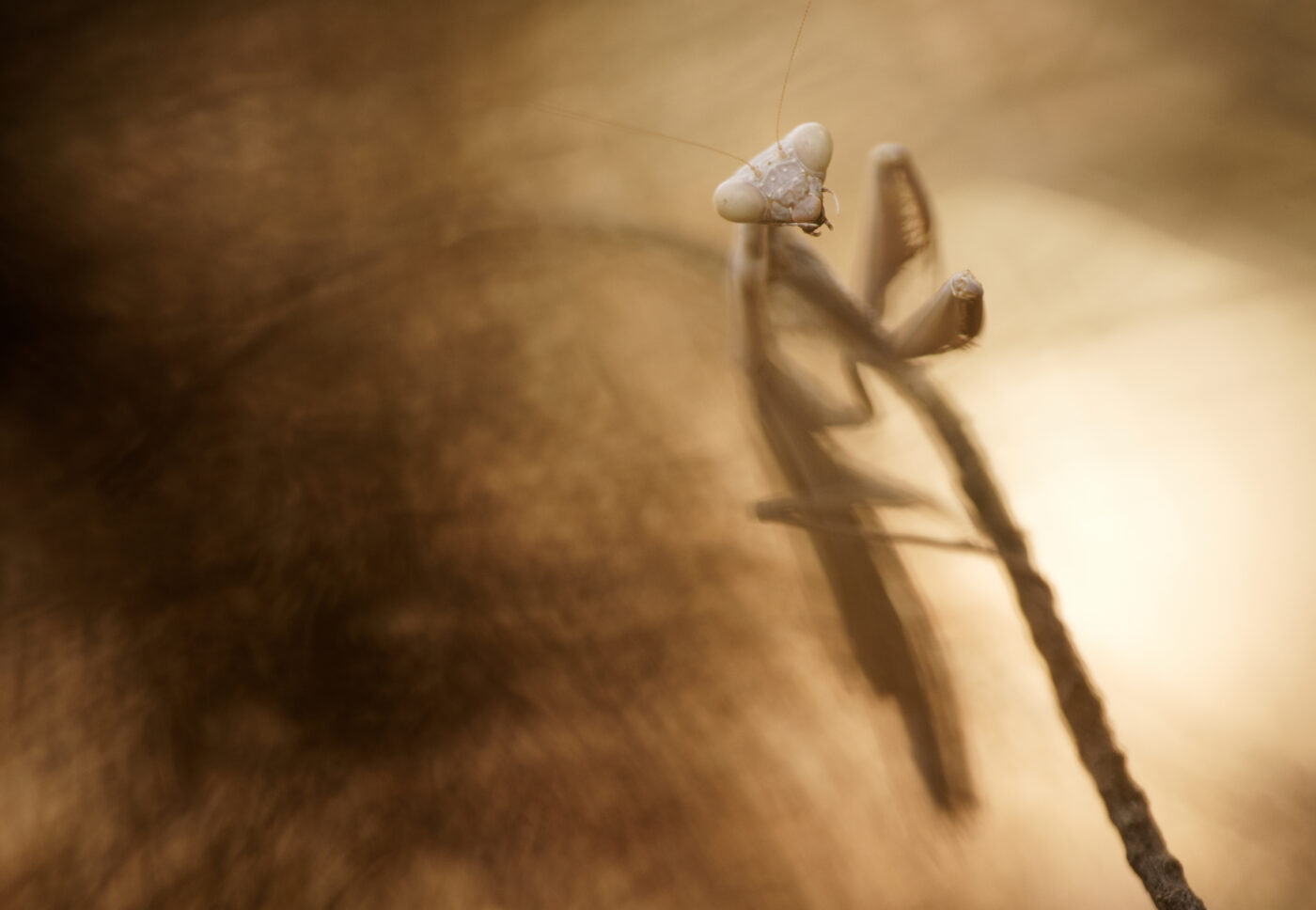
Fading in a brown world
Panagiotis Dalagiorgos
Mediterranean mantis, Iris oratoria.
An Iris oratoria on a branch.
“I chose a wide aperture because I wanted the branch and the mantis’ body to fade away in my composition. I split my background in two parts, a dark part with a textured surface, and a light part with a flat surface.”
Greece
- Mantises
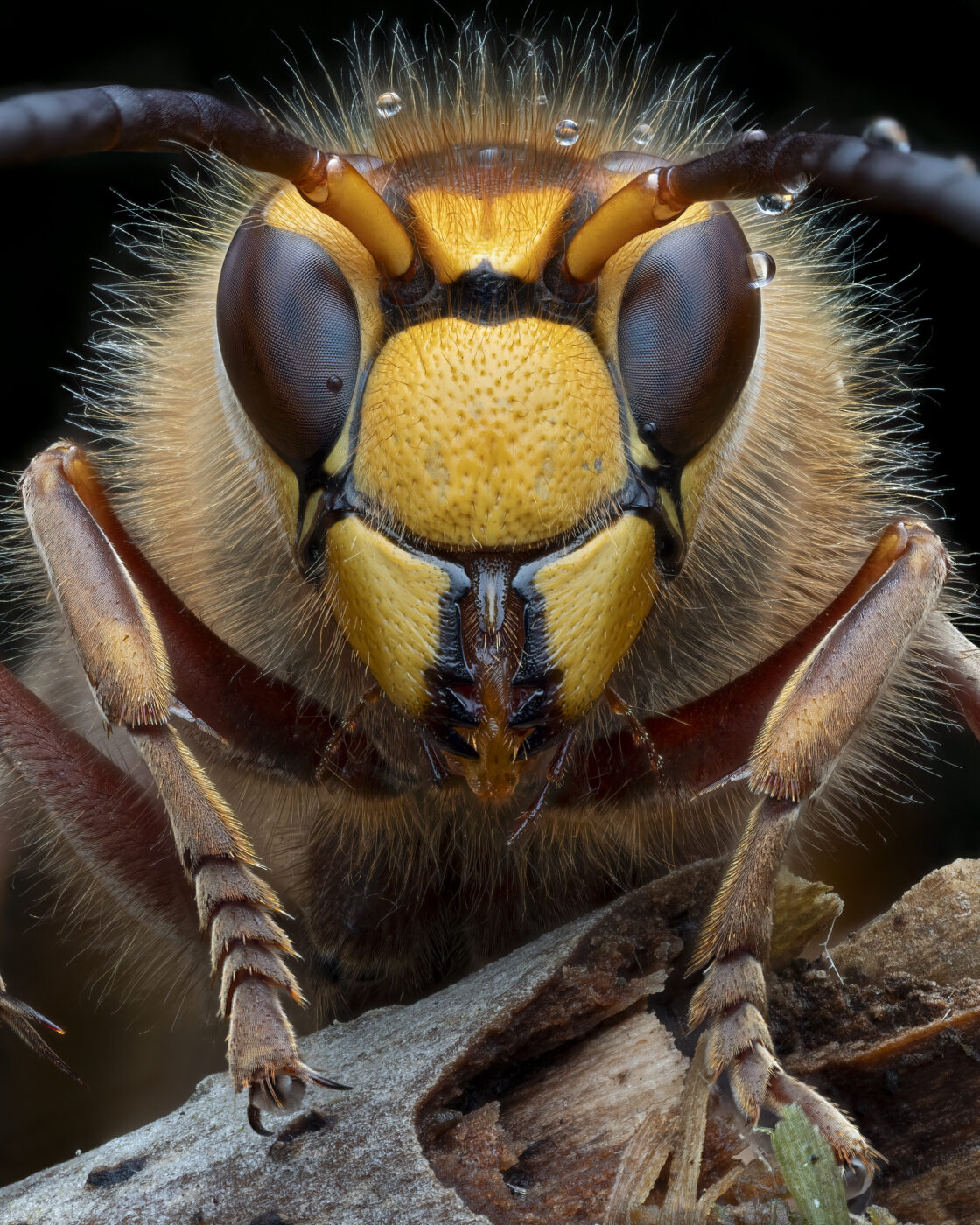
The Hornet
Pete Burford
European hornet, Vespa crabro.
A European hornet found resting from the rain in late October, they are more docile due to low temperatures which means you are able to get shots of them, I picked this one up onto a stick and took the shots that I need before leaving it back by the Hornets nest.
“I recently found a Hornet nest locally and have been going back to it every week till the Hornets were calm enough due to the temperature for me to get some photos of them. I wanted a really detailed portrait and I was lucky enough to get the Opportunity.”
United Kingdom
- Ants, bees, wasps and sawflies
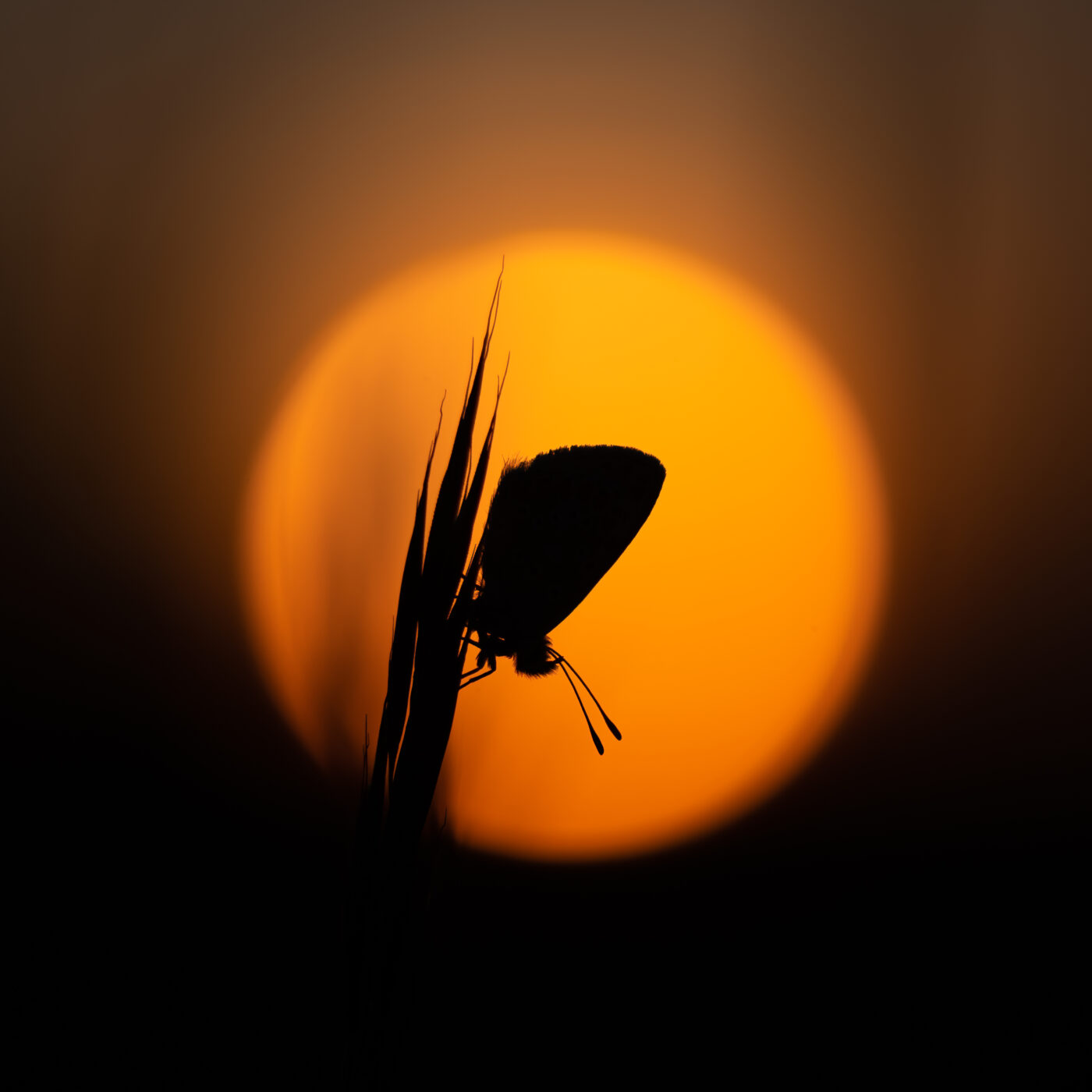
Brown Argus roosting at sunrise
Richard Sheldrake
The sun is rising behind a Brown argus butterfly as it starts to awaken from roosting.
“I start very early, before dawn and search for the butterflies as they start to climb higher up grass stems to get the early sun warmth. On this day, I found this beauty on a long grass stem on the top of a bank, so I could get right down low to catch the sun in the background.”
United Kingdom
- Butterflies and moths
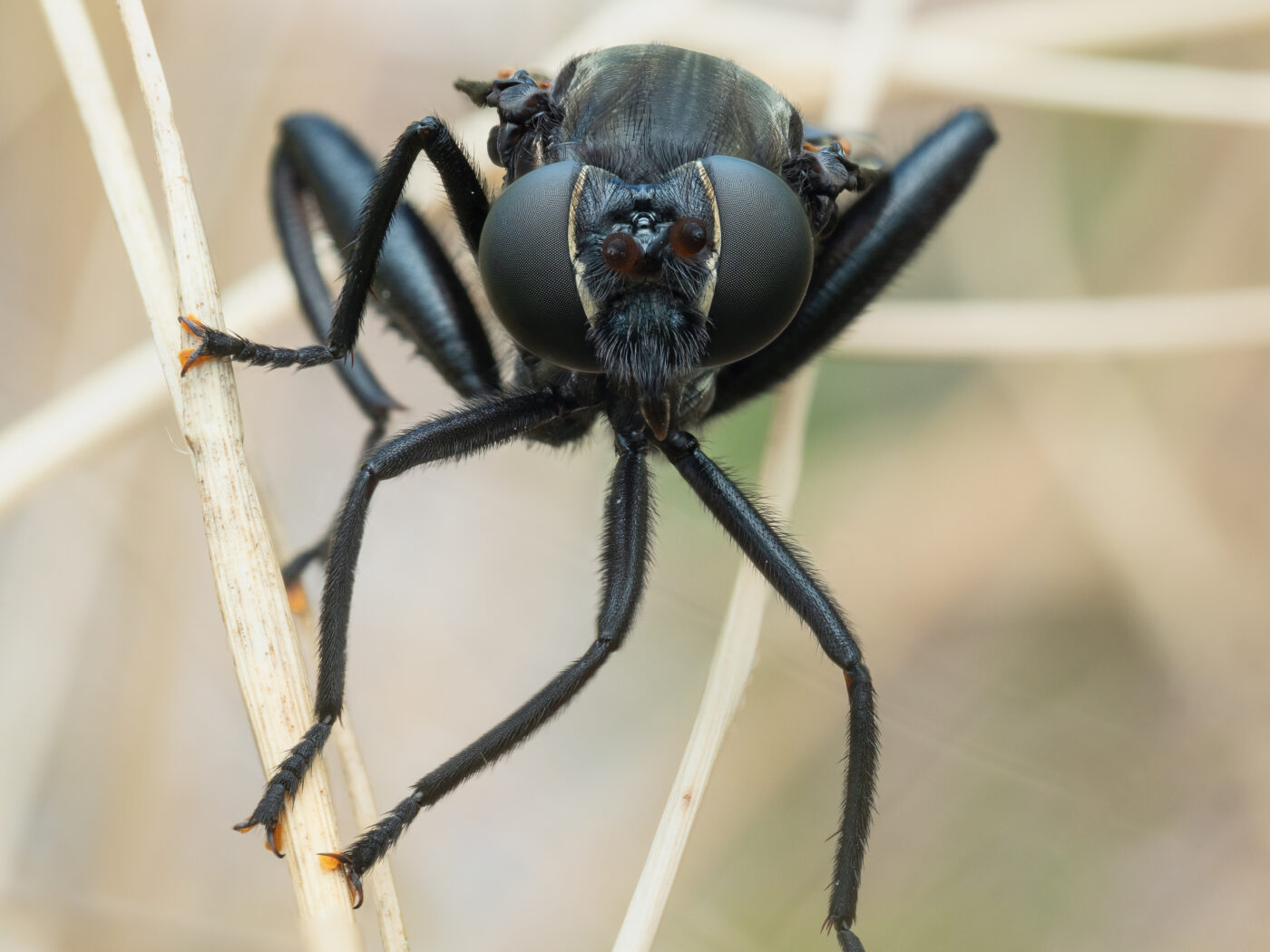
Mydas fly portrait
Jamie Spensley
Clubbed mydas fly, Mydas clavatus.
A portrait of a mydas fly roaming through the beach grass in Key West, Florida.
“I was walking along a quiet beach on holiday in Key West, Florida. I heard a huge buzz in the grass. I thought this was a huge wasp at first but when I was taking photos, I noticed it had fly like eyes. I later found out that they mimic wasps and can’t bite or sting.”
United States
- True flies
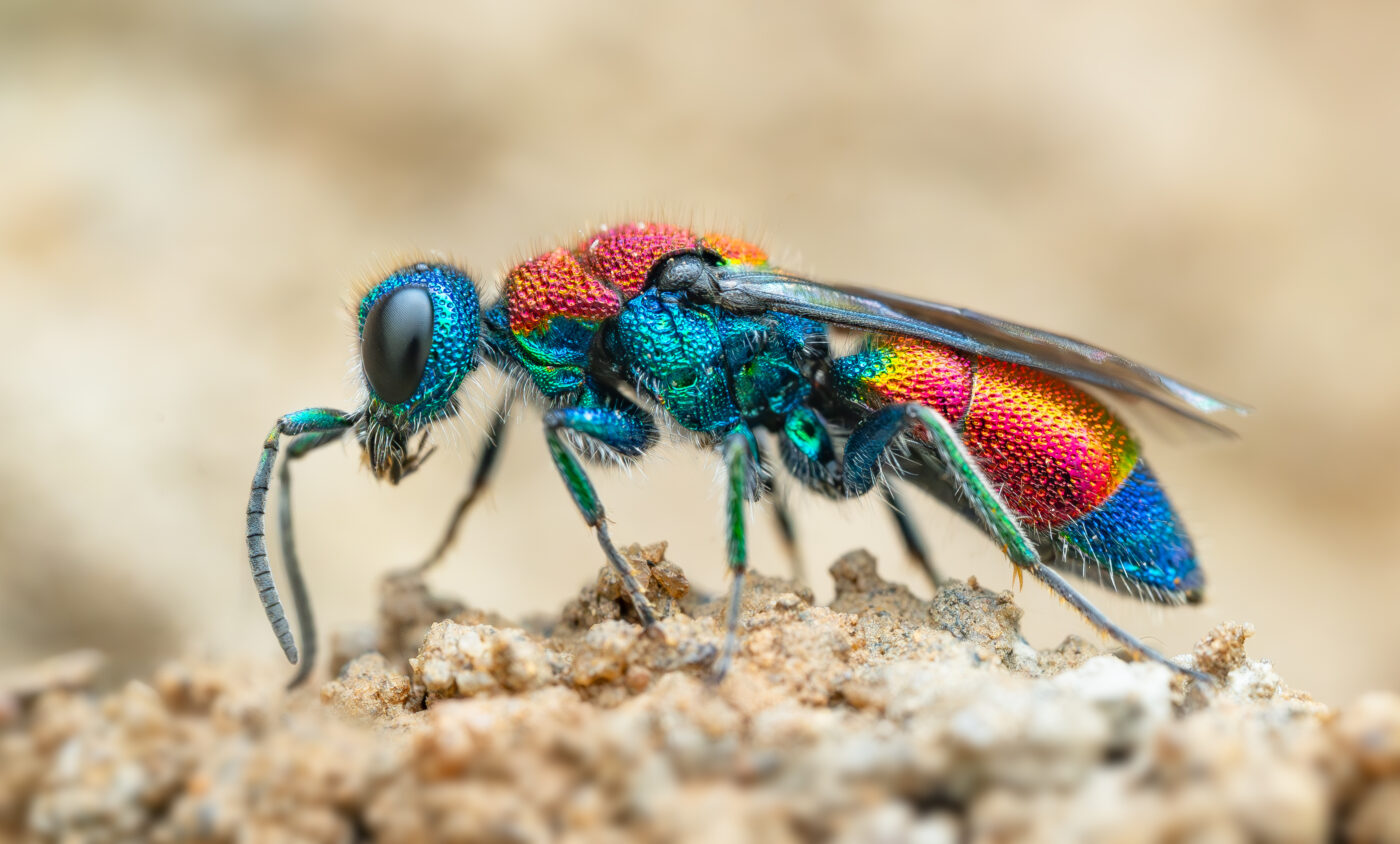
Chrysis viridula
Tim Jonas
Cuckoo wasp, Chrysis viridula.
Chrysis is a genus of cuckoo wasp, so called because they infiltrate the nests of other wasps and bees, laying their eggs alongside their hosts’ offspring. This species, Chrysis viridula, has a spectacular metallic sheen and targets the nests of potter wasps (Odynerus spinipes).
“On a sunny summer afternoon I was photographing Spiny-legged Mason Wasps (Odynerus spinipes) constructing elaborate entrances to their nests along steep clay banks. The nests were attracting parasites (Chrysis viridula) which I captured entering host nests to lay their eggs.”
United Kingdom
- Ants, bees, wasps and sawflies
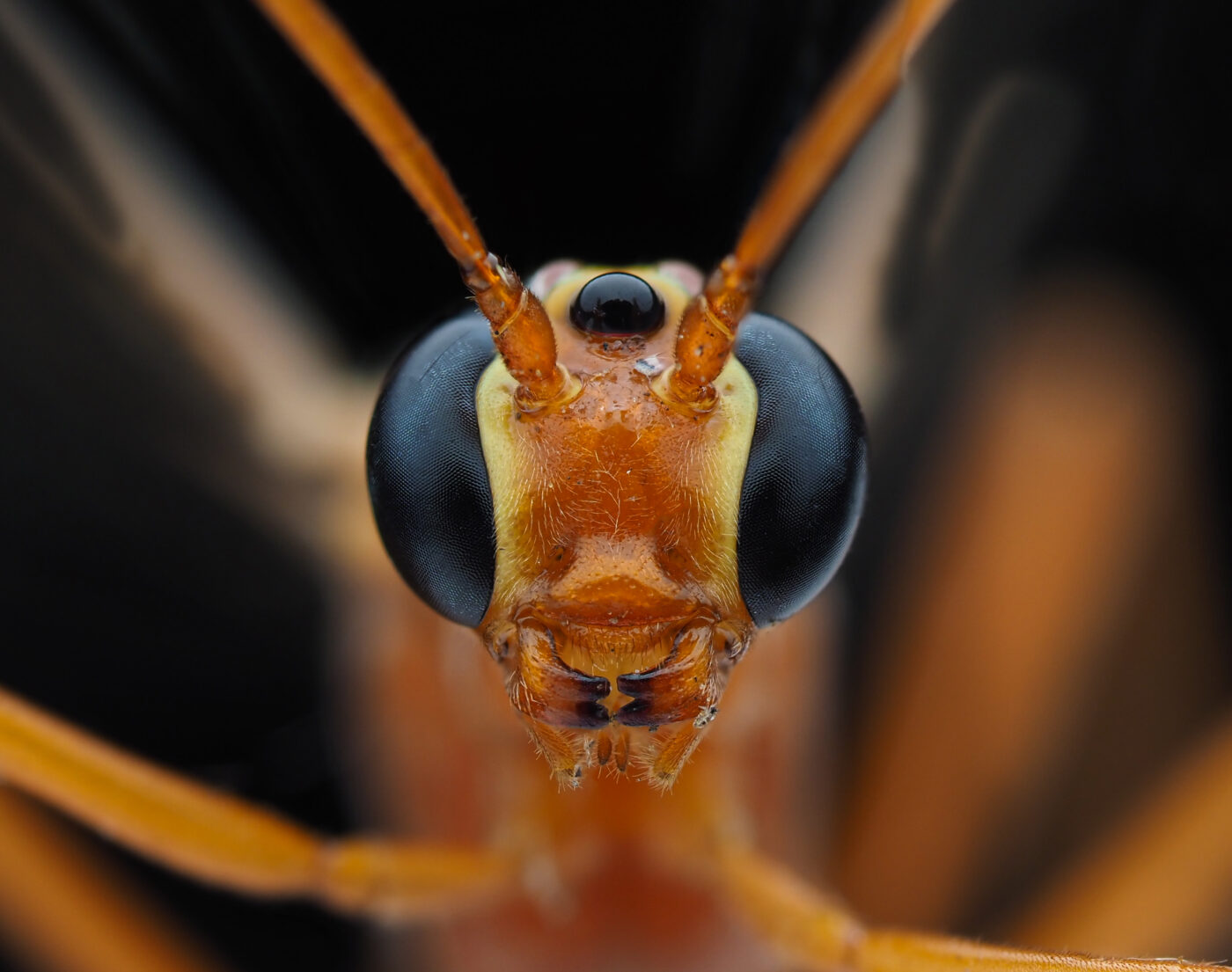
Third Eye
Ben James
Ichneumon wasp, Ichneumonidae.
This Ichneumons species was found in my moth trap.
“I found this guy chilling by my moth trap and he was kind enough to sit still for a portrait.”
United Kingdom
- Ants, bees, wasps and sawflies
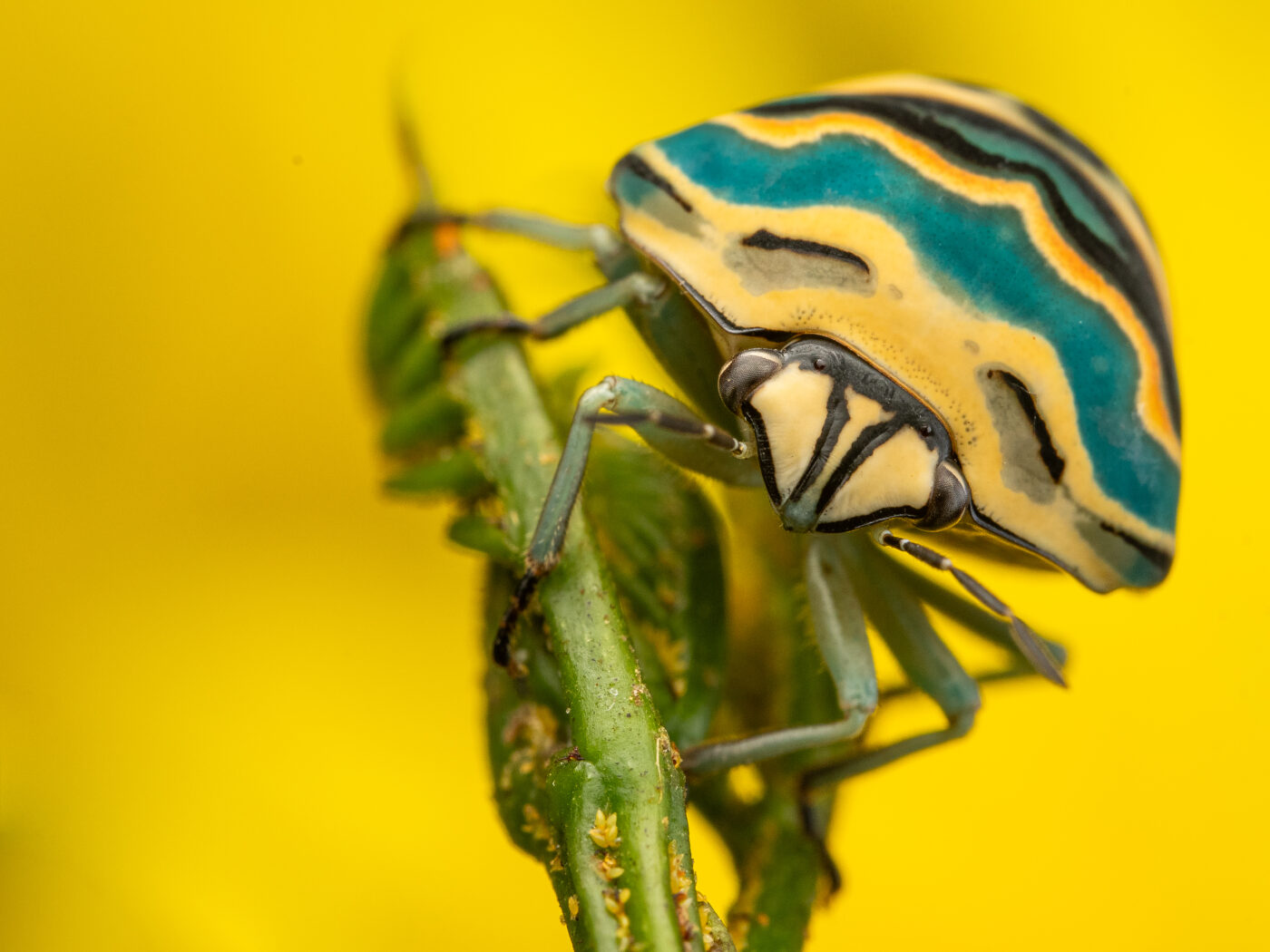
Picasso Bug
Robin Backhouse
Picasso bug, Sphaerocoris annulus.
This is a portrait of an aptly-named Picasso bug (Sphaerocoris annulus) from Ruiru in Kenya.
“This insect was found in the local area and photographed in situ. They don’t sit still for long so I had to be patient to get the face-on composition.”
Kenya
- True bugs
Specially Commended – Environment
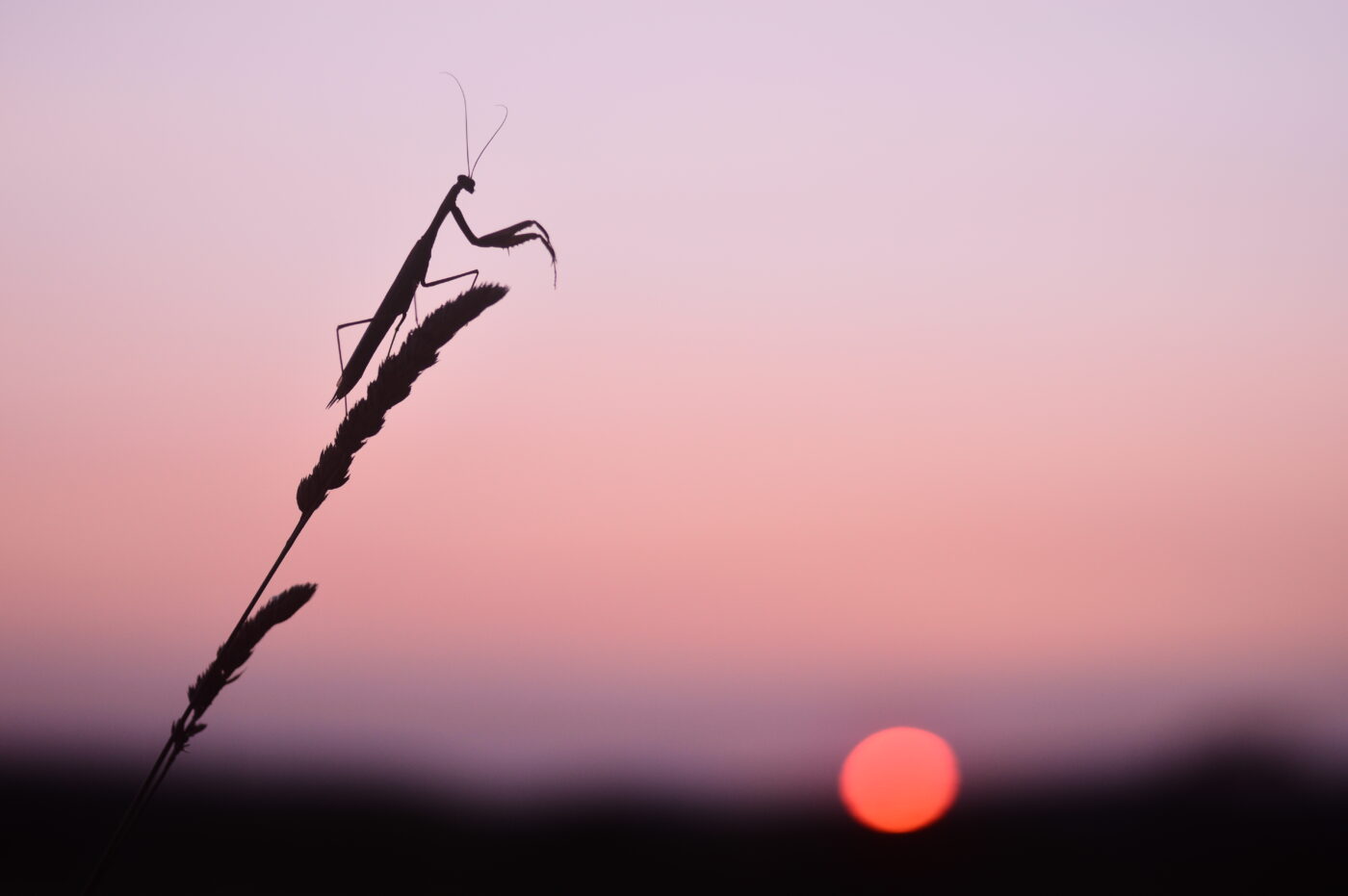
Evening prayer
Leela Channer
European mantis, Mantis religiosa.
A praying mantis saluting the evening sun.
“I discovered this autumn mantis while walking along the edge of a ploughed field and lay on the ground to photograph it silhouetted against the sky just before the sun dipped behind the hills.”
France
- Mantises
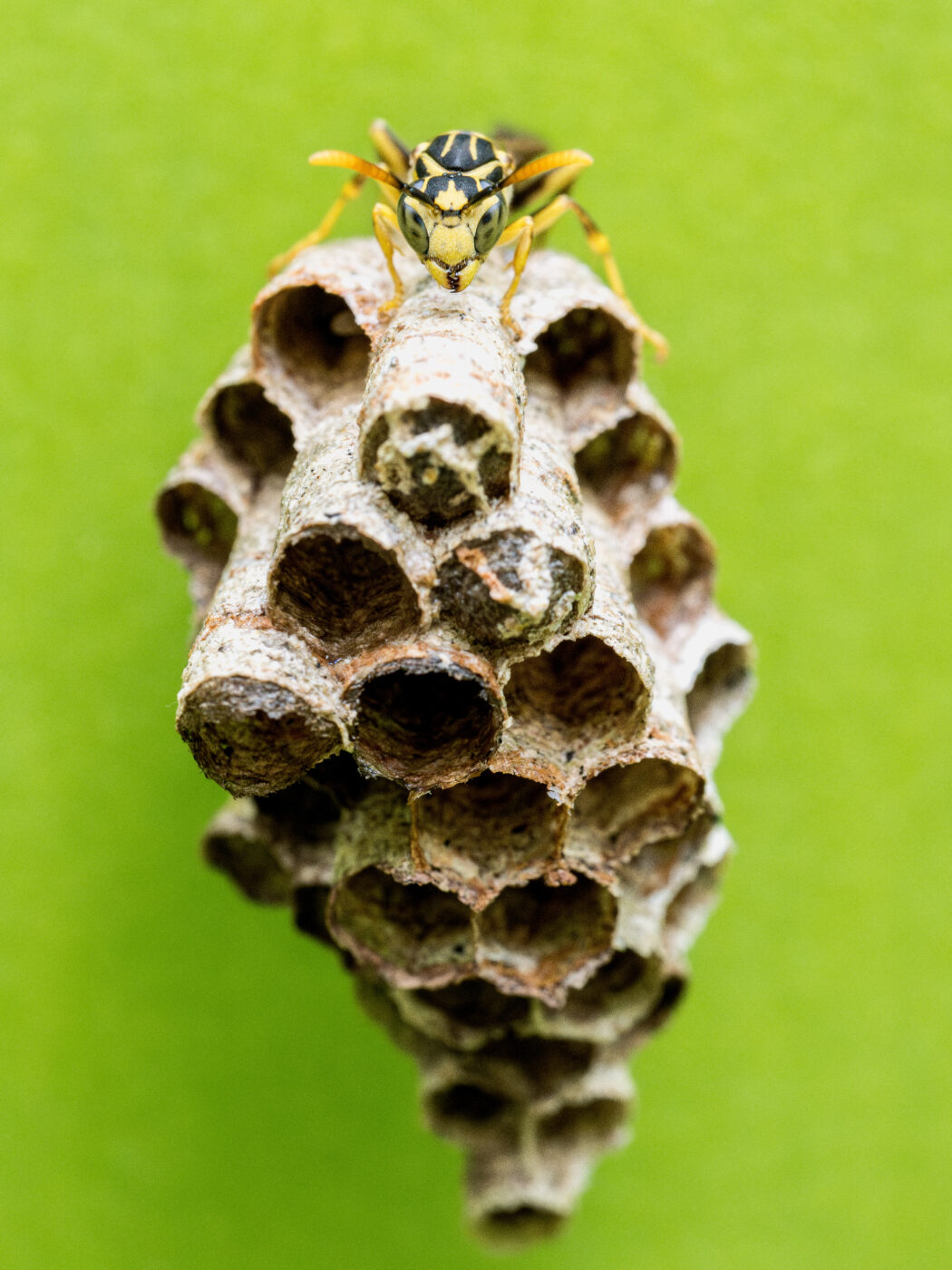
Guardian
Dan Osipov
Paper Wasp, Mischocyttarus sp.
A lone wasp stands guard on a nest in Tatama National Park, Colombia.
“The nest was hanging on a plant near the side of the road. I’ve noticed the wasp crawling on it. After some time it took position right at the top and faced the camera for a brief moment, letting me take this picture.”
Colombia
- Ants, bees, wasps and sawflies
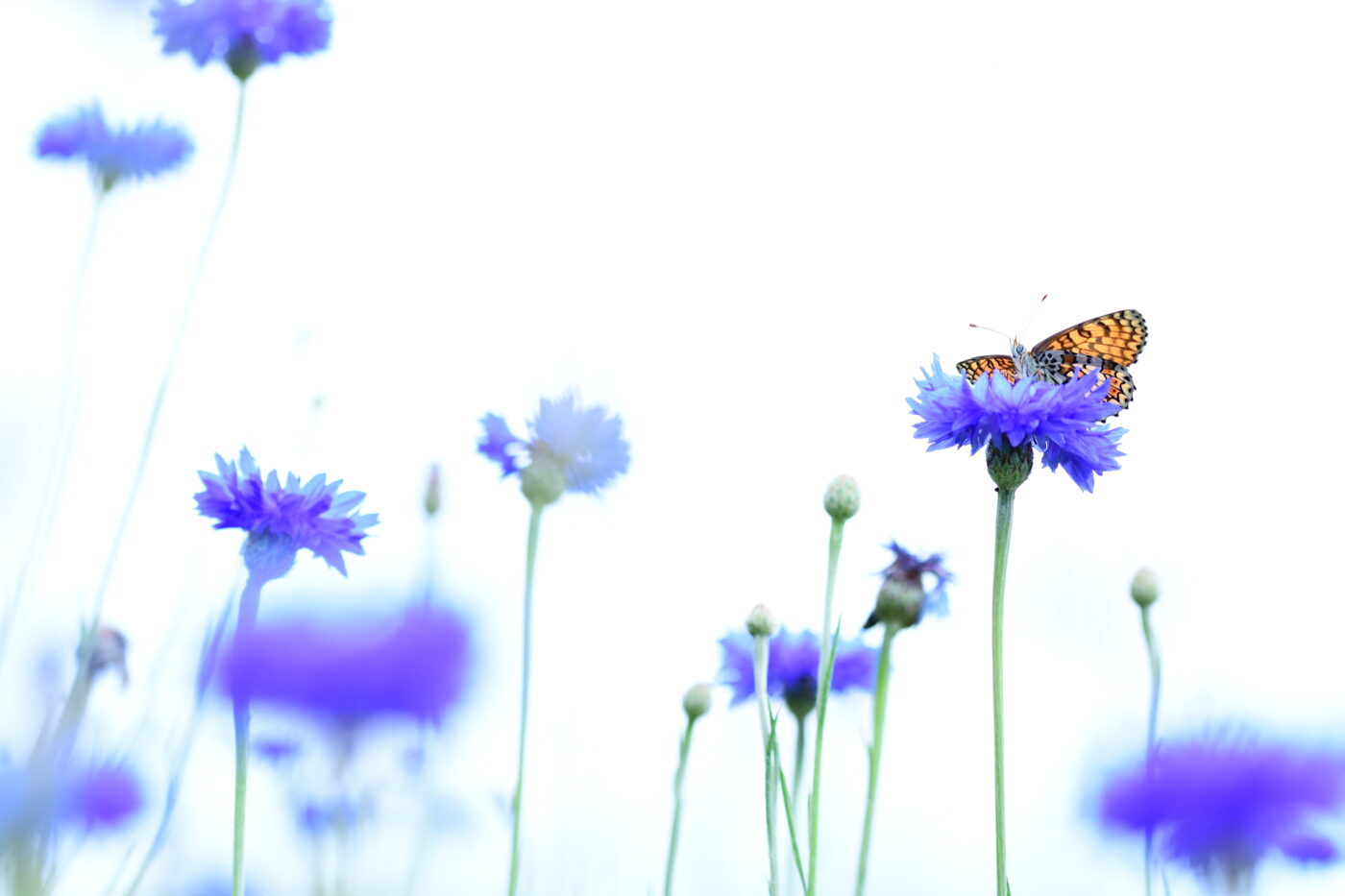
In the cornflowers
Leela Channer
Glanville fritillary butterfly, Melitaea cinxia.
“I really liked the bright colours of this fritillary basking in the cornflowers in the garden on an overcast day. We’d seeded some wildflowers in the garden several few months before and when I took this photo just the cornflowers were out. I was very happy to find this Glanville Fritillary basking, and knelt down to capture a high key shot with the contrasting orange and purple.”
France
- Butterflies and moths
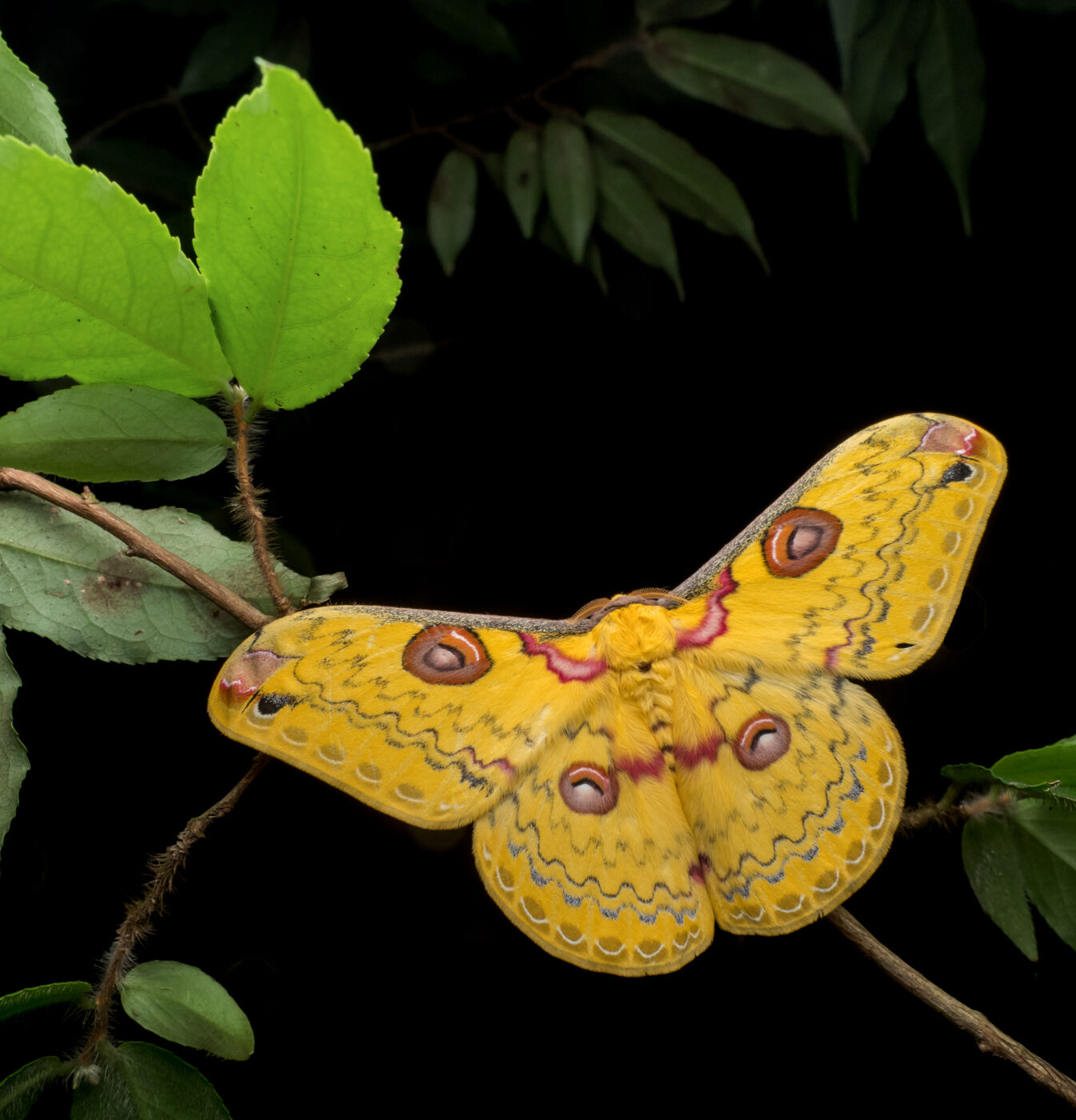
Golden Emperor
Marco Chan
Emperor moth, Loepa sp.
A golden emperor moth rests on a perch after gliding in the summer night.
“A golden emperor moth glides onto a nice perch on a summer night. This was my second encounter with this species and I’ve always wanted to show the contrast between the bright colour of the moth with the darkness of night.”
Hong Kong
- Butterflies and moths
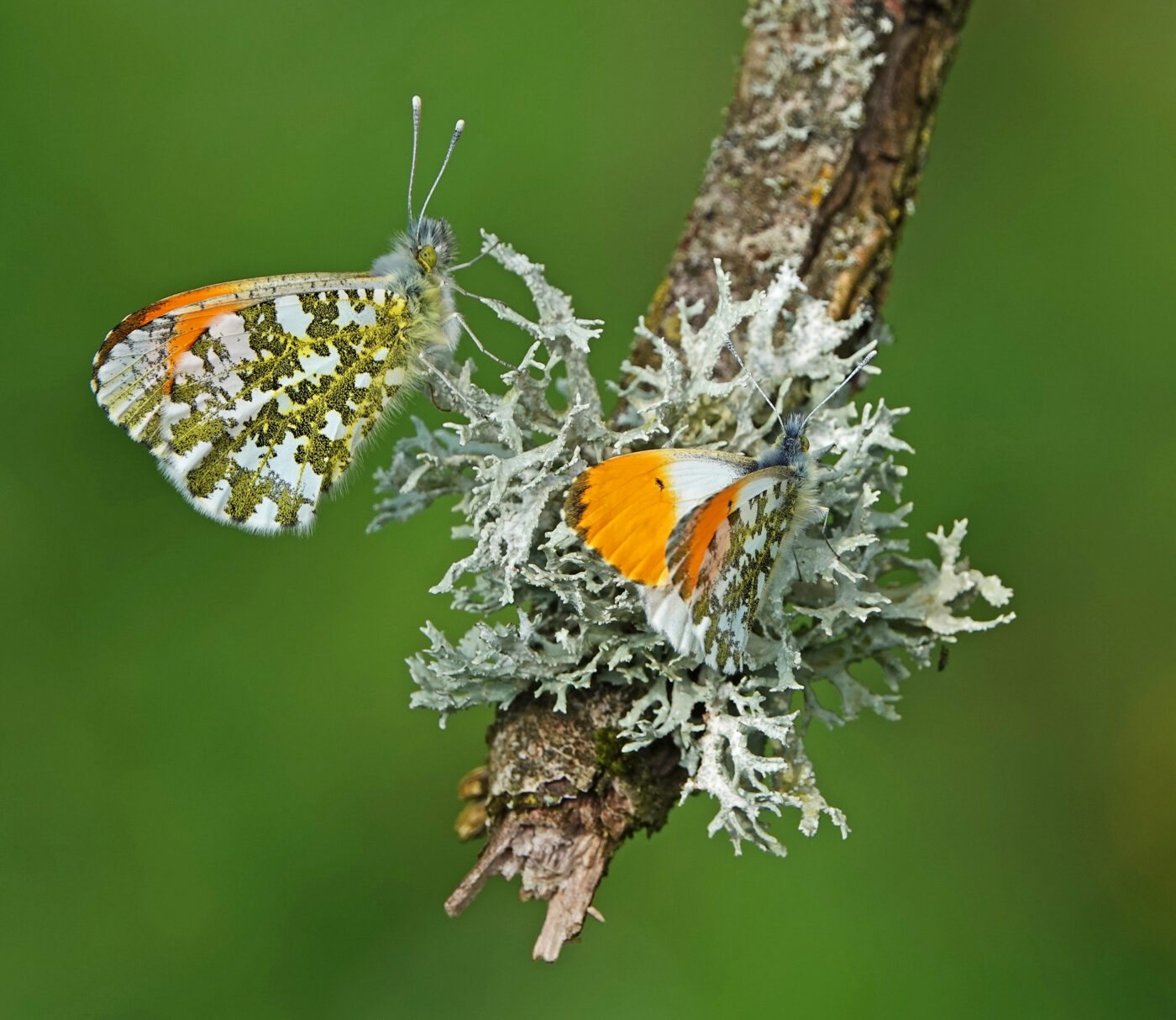
Taking a Break
Thomas Roberts
Orange-tip butterfly, Anthocharis cardamines.
“I believe these two male Orange-tip butterflies are merely resting on this lichen decorated branch. Whatever their reason for being there I was glad they felt secure enough to allow me to get this colourful image. The image was captured in my local wild flower meadow. I’m there on a daily basis, always with Hari, our border collie, in tow. Thankfully he’s a patient lad and puts up with me spending rather a long time on hands and knees in ‘Insect Safari’ mode!”
United Kingdom
- Butterflies and moths
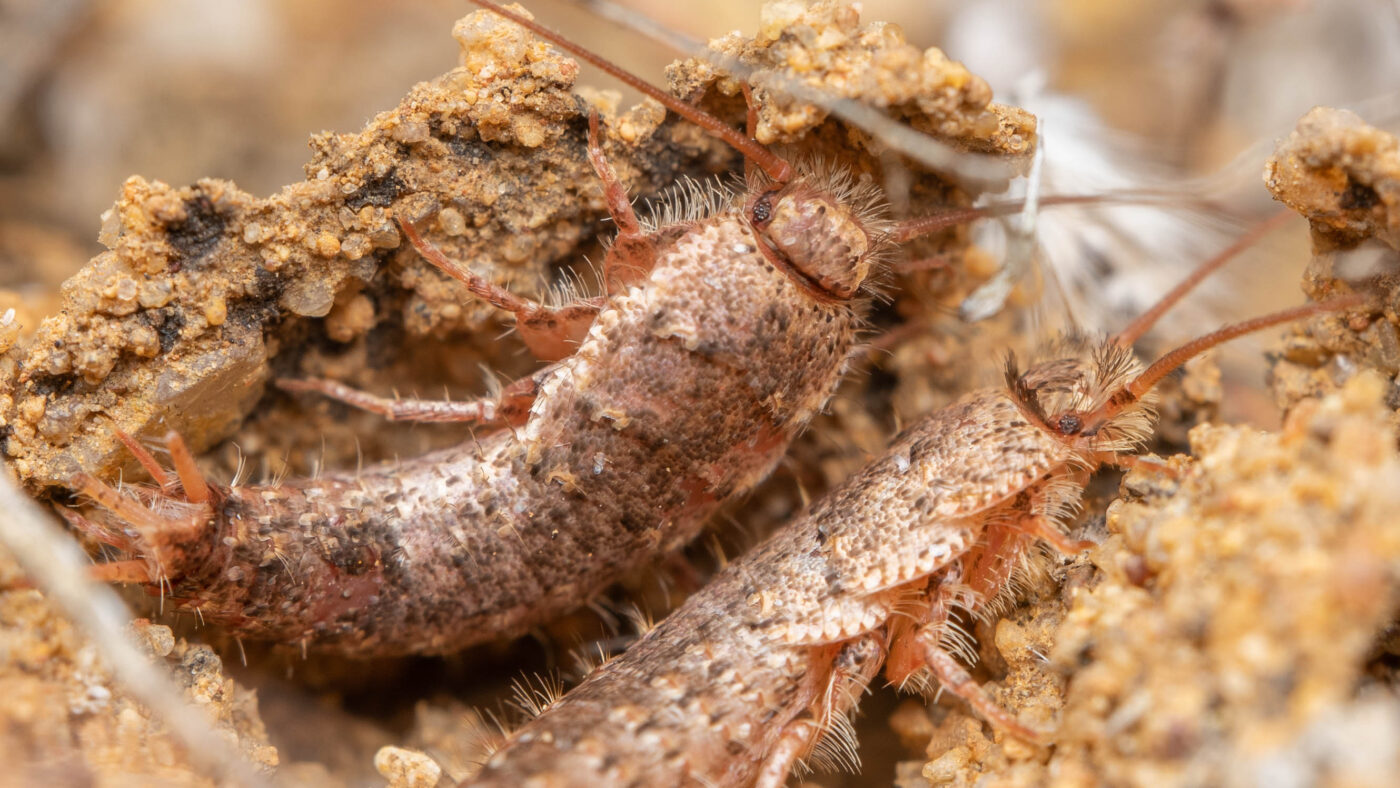
A pair of silverfish
Frank Ashwood
Silverfish, Lepismatidae.
These silverfish appeared to be clinging together inside a small, clayey nest structure, and refused to abandon each other when a camera lens pointed in their direction. Some of their brilliant silver scales have rubbed off, which may indicate moulting is about to take place.
“I recently had the opportunity of taking my camera around several farms across Australia. This photograph was taken in Western Australia, in a very dry area of sandy soils. Patience was a real virtue here – it took a lot of test shots to get both silverfish’s eyes in focus!”
Australia
- Silverfish and firebrats
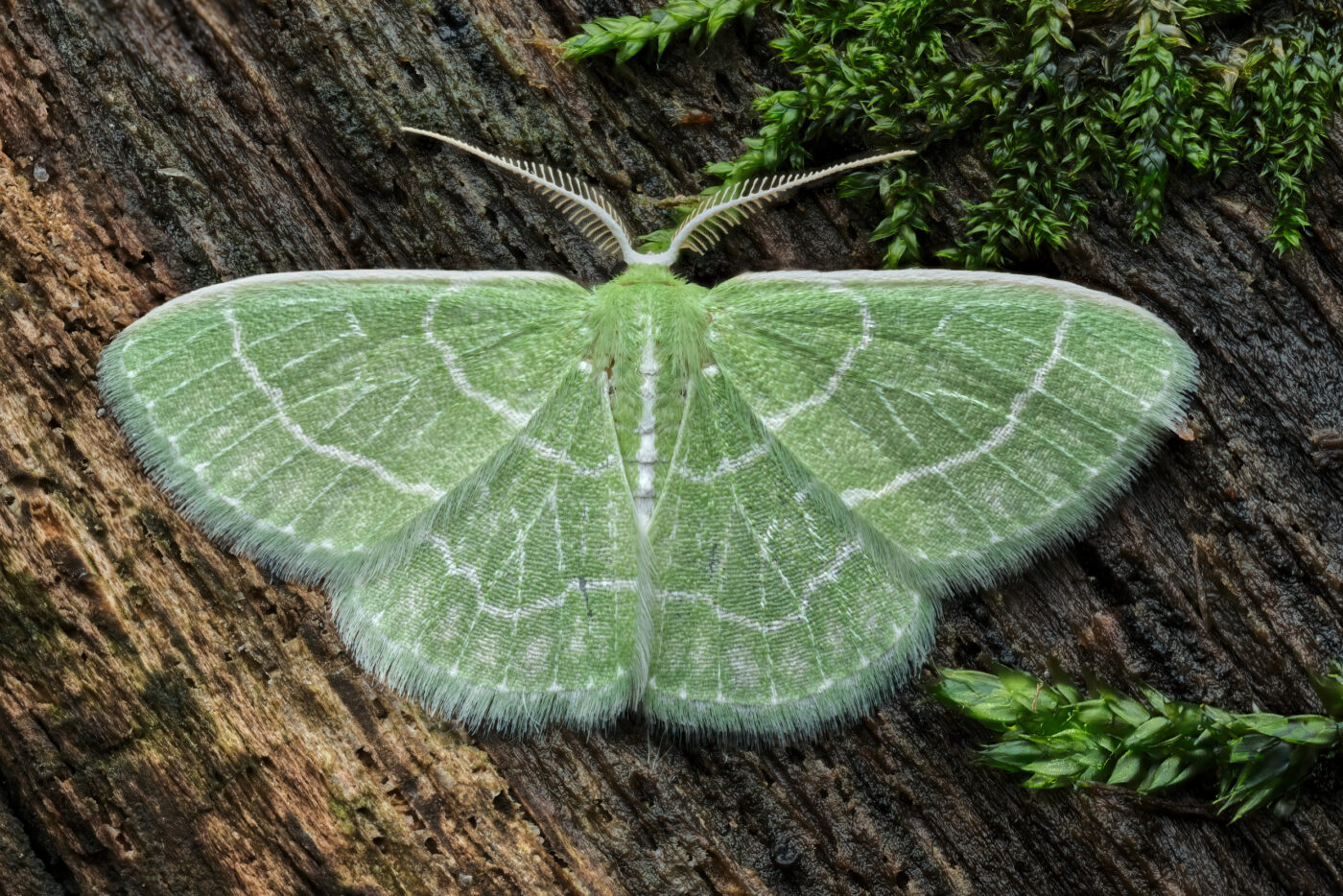
A Forest Gem
ALEXANDER MCKERRACHER
Wavy-lined Emerald Moth, Synchlora aerata.
This photo features a beautiful Wavy-lined Emerald Moth sitting on a mossy log. Taking a break from it’s adventures through the trees, this moth is displaying all of it’s beauty for use to appreciate.
“A couple macro photographers and myself went camping at Awenda Provincial Park in Ontario. We were looking around the edge of our campsite on the first night and I spotted this moth sitting perfectly still on the log. It being a cold night, I was able to take this 33 frame stack.”
Canada
- Butterflies and moths
Specially Commended – Smartphone
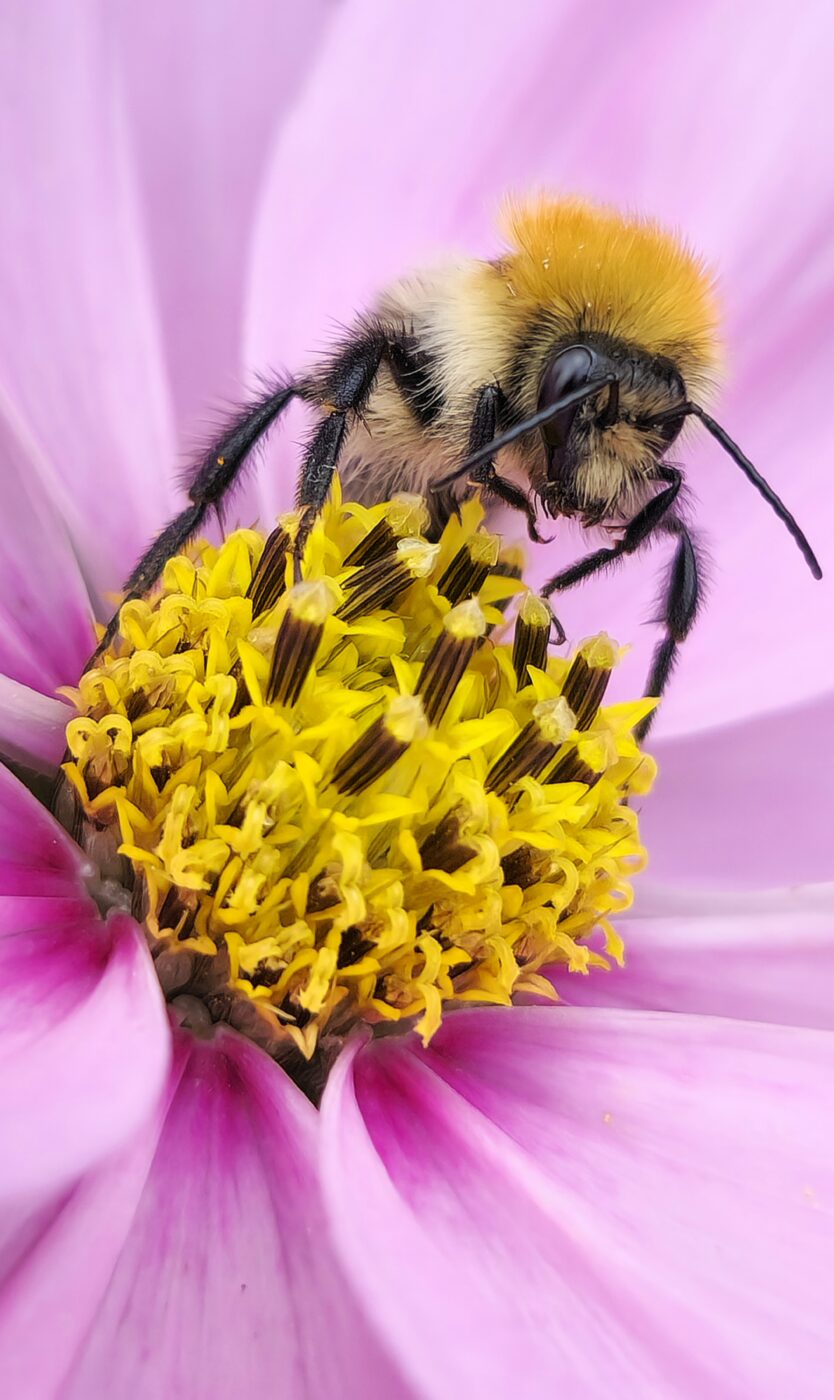
Pollinator
Michael Wood
Common carder bumble bee, Bombus pascuorum.
“A bee doing bee things. I have been spending lots of time in the garden as I can’t do too much while recovering from illness so it’s been a bit of a lifeline to me.”
United Kingdom
- Ants, bees, wasps and sawflies
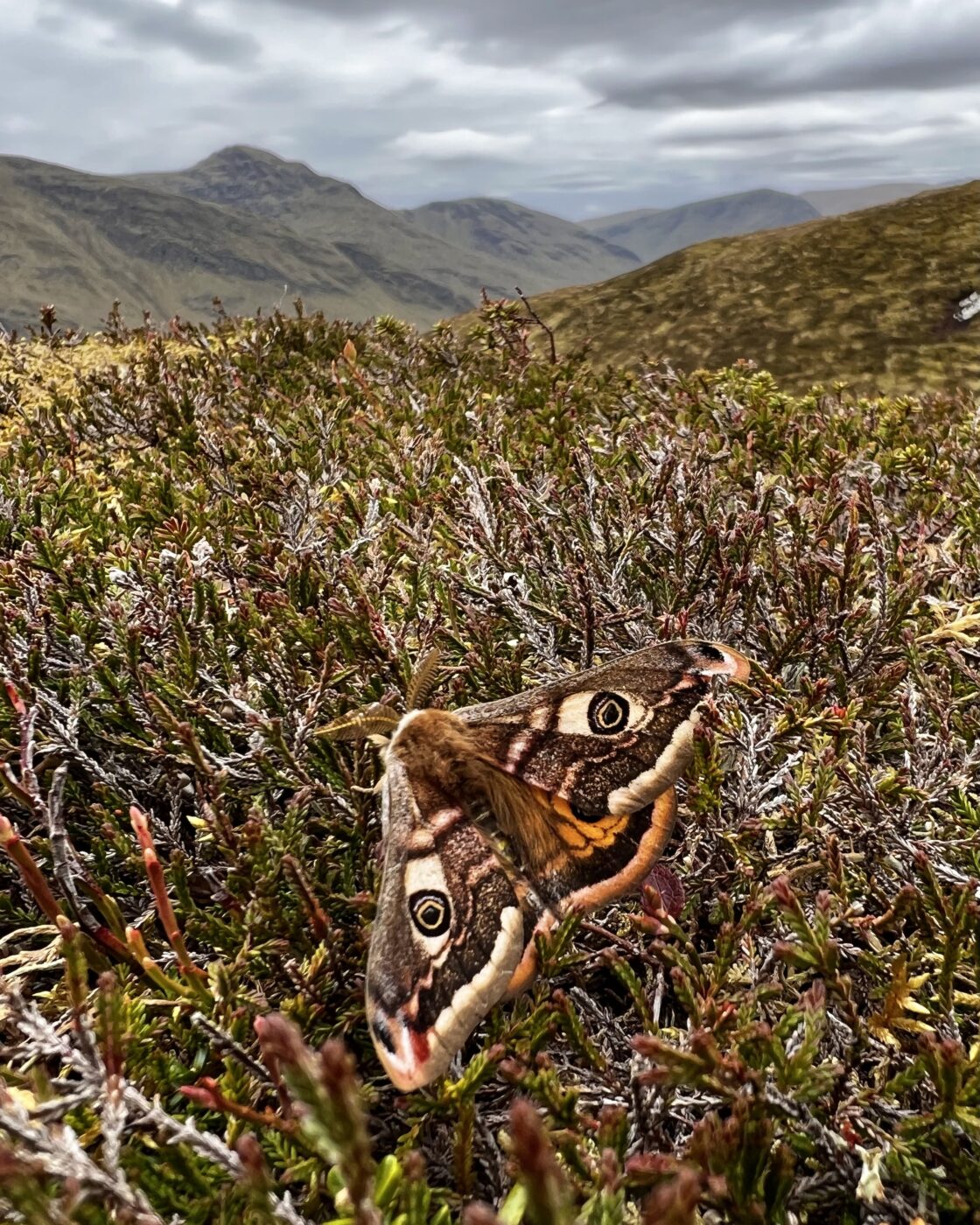
Moths and mountains
Marian Coburn
Emperor moth, Saturnia pavonia.
A male Emperor moth (Saturnia pavonia) at rest on heather on the slopes of Meall Buidhe with the peak of Stuchd an Lochain in the background. These are two Scottish mountains (Munros). Photo taken in May 2023, Glen Lyon.
“This shot is the result of combining two of my main interests- Munro bagging/hiking and moth recording. This shot captures the unforgiving and rugged mountainous habitat these moths can survive in in Scotland.”
United Kingdom
- Butterflies and moths
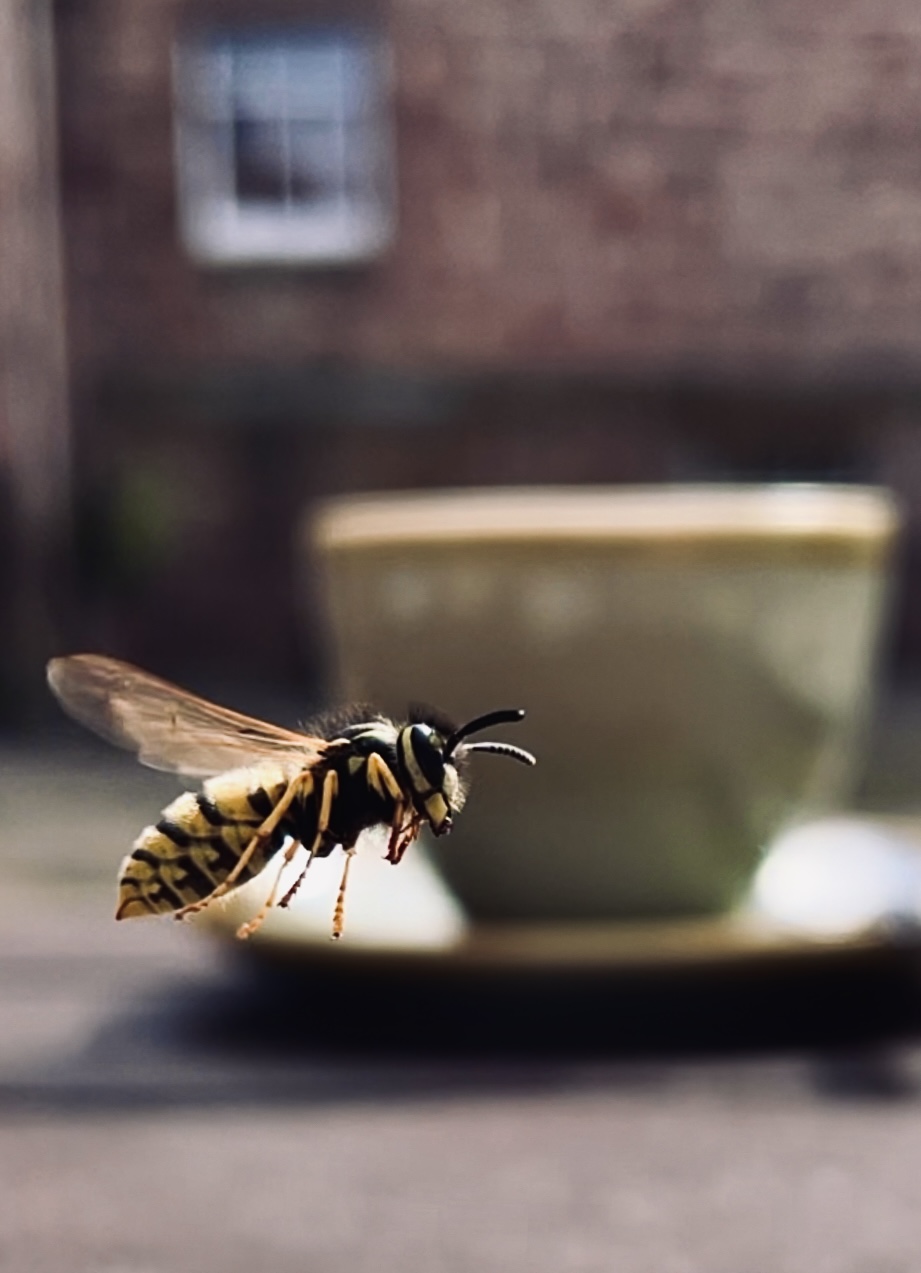
A wasp who joined us for a cream tea
Abi Batten
German wasp, Vespula germanica.
“Wasp who seemed to enjoy sharing a cream tea with us, favoured raspberry jam over blackcurrant and was very polite. My eight year old son is actively working on his wasp phobia. This was the first wasp he’s managed to stay calm around, and we enjoyed photographing it while it was hanging out with us.”
United Kingdom
- Ants, bees, wasps and sawflies

